Compiled by Geoff Goodall

It was owned by the Drage Historic Aircraft Collection, housed in a large hangar at this farm. Photo by Geoff Goodall
The first production model was the Percival "D" Series Gull, 29 built by George Parnall and Company at their works at Yate, Gloucestershire under contract to Percival Aircraft Co Ltd. They were designated D.1 or D.2 depending on engine installed, top/side hatch cockpit entry and tripod undercarriage legs, but were all called Percival Gull IV. In 1934 Percival Aircraft Co Ltd established its own works at Gravesend Airport, Kent. Here 19 type D.3 Gulls named the Percival Gull VI were built, featuring side opening cockpit doors and single leg undercarriage with spats, powered by a 200hp Gipsy Six.
In November 1935 the new “K” design Percival Vega Gull four-seater was introduced. It resembled the Gull VI but was an entirely new design with wider fuselage for a comfortable 4-seat cabin, wider undercarriage track and greater payload. Better streamlining resulted in improved performance from the same Gipsy Six engine. 90 Vega Gulls were built.
The Vega Gull design subsequently underwent modification for the military, to become the Percival Proctor Mk.I, II & III, a total of 878 built to British wartime orders.
The operation was named Connellan Airways and grew into a major Outback airline, later renamed Connair with a fleet of DH.114 Herons, DC-3s and a F.27. Eddie Connellan later wrote in his book Failure of Triumph that the Percival Gulls were operationally unsuitable because of the rough airstrips, but their cruising speed made them the best he could obtain at the time. They required continual repair and he praised the Department of Civil Aviation for its cooperation in allowing him to make various modifications to the airframes and power plants.
They became A32-2 & A32-1 respectively and served the war from Laverton with No.1 Communications Flight (later renamed No.1 Communications Unit). Both survived RAAF duty and were made available for civil disposal during 1945, returning to their pre-war civil registrations
"After the Fox Moth and Moth, this one climbed like a cat up a wall. 10,000 feet was no trouble at all and enabled us to get above the bumps and the heat and give the passengers a better ride. UZH became very popular with the local folk. Take off and landing approach was quite flat after the biplanes and the climb ever so much better, with all those extra horses under the cowling. Actually Edgar Percival's product compared very favourably in 1937 with the small American types of 1960, without being cluttered up with gadgetry."
| .33 | Built at Yate Aerodrome, Gloucestershire by George Parnell & Co under contract to Percival Aircraft Co. Model D.1 Gull Four I, Cirrus Hermes IV |
| 20.3.33 | Registered G-ACAT Edgar W. Percival, London |
| 22.3.33 | British CofA issued |
| .33 | Ordered by Charles E. Kingsford Smith, who was Australian agent
for Percival, for the 1933 Mackay Aerial Survey Expedition headed by
Donald Mackay. (Mackay was a Cootamundra NSW grazier who had mounted expeditions to New Guinea, and from 1930 conducted a series of expeditions to explore remote inland areas of central Australia, previously using aircraft hired from Larkin Aircraft Supply Co, Melbourne as support aircraft.) |
| 3.33 | Packed and shipped to Australia |
| 4.33 | Struck-off British Register as sold to Australia |
| 9.5.33 | Arrived Sydney from England as cargo on the ship Hobson’s Bay |
| 5.33 | Assembled at Mascot Aerodrome, Sydney in two days |
| 13.5.33 | Testflown at Mascot by Frank Neale, who had been the pilot for previous Mackay Expeditions |
| 18.5.33 | Registered VH-UQW Mr. Donald Mackay, Sydney NSW |
| 18.5.33 | Australian CofA issued at Mascot. Type quoted as D.1 Gull 4, engine 130hp Gipsy Major |
| 5.33 | Naming ceremony at Mascot, named Chateau Tanunda |
| 21.5.33 | Departed Mascot to commence the 1935 Mackay Aerial
Expedition of central Australia, pilot Neale. A DH.60 Moth was also used by the expedition |
| 9.7.33 | Minor damage at Lake Anec NT when the Gull nosed over on soft surface.
Aircraft was moved to hard ground by packing mulga bushes under the
wheels. This lake was named by a previous Mackay expedition, after the Larkin ANEC aircraft then being used. |
| 16.7.33 | The party returned to Mascot. The expedition had covered 260,000 square miles. |
| 29.7.33 | Change of ownership: Captain J. R. Patrick/James Patrick
& Co Ltd/Patrick Steamers Pty Ltd, Sydney. To be used to carry personnel of this stevedoring company between Australian shipping ports. Frank Neale was retained as company pilot |
| 18.6.34 | CofA renewed at Mascot. Total time 700 hrs, only 35 hours had been flown since last overhaul |
| 35-37 | Operated by Frank Neale on charter flying under name Neale’s Air Service Ltd, Sydney (Letterhead used same address as Patrick Steamers) |
| 29.5.35 | CofA renewed at Mascot, operator Neale's Air Service Ltd. Total time 1,111 hours |
| 17.1.36 | Damaged by wind storm at Tennant Creek NT. The parked aircraft was lifted off the ground and dumped on its wheels a distance away. Pilot F. Neale, Owner J.R. Patrick |
| 3.3.36 | Repairs completed at Mascot by De Havilland Aircraft Pty Ltd |
| 1.5.36 | CAB Inspection report at Mascot. Total time 1,264 hours |
| 10.2.37 | Change of ownership George E. Ryder, Rover Motors, Cessnock NSW. Based at Newcastle Aero Club, Broadmeadow airfield, Newcastle |
| 23.5.37 | CAB Inspection report at Broadmeadow. Total time 1,463 hours |
| 9.10.37 | Last flight, retired pending sale |
| 22.11.37 | Change of ownership: Patrick G.Taylor, Sydney |
| 6.38 | Under overhaul by De Havilland Aircraft Pty Ltd at Mascot. Has not flown since 9.10.37 |
| 18.6.38 | Testflown Mascot after overhaul, pilot P.G. Taylor |
| 6.6.39 | CofA renewal at Mascot, testflown by O. B. Hall |
| 2.7.39 | Port undercarriage and wing damaged when the aircraft struck a rut in the ground while taxying at Coonabarabran NSW with two passengers. Pilot H. Ross was conducting joyrides. Owned P. G. Taylor |
| 27.7.39 | Testflown Mascot after repairs by Airflite Pty Ltd, pilot H. G. Ross |
| 17.8.39 | Sold to Warrego Flying School, Cunnamulla Qld Before delivered it was resold by agent Charles Matheson of Archerfield, to James Beel |
| 21.8.39 | Change of ownership: James B. Beel, "Harriman Park" Station, via Cunnamulla Qld |
| 26.7.40 | Annual CofA expired |
| 16.8.40 | CofA renewed at Archerfield, testflown by pilot C.R. Broome. Total flying time 1,677 hours |
| 5.4.41 | Forced landing due engine failure in a field near the town Cunnamulla Qld, no damage. Towed on its wheels to a hangar at Cunnamulla airfield where the cause was found to be a hornets nest had caused an air blockage to the engine. |
| 26.8.41 | Annual CofA expired. Beel wrote to DCA explaining that he was unable to ferry it to Archerfield at that time due sheep shearing on his property. |
| 24.4.42 | Letter from Director General of Civil Aviation to Department
of Air in response to enquiry concerning availability of civil aircraft
which could be impressed for RAAF use by Western Command: "The following aircraft could reasonably be made available for use in communication flying in Western Australia - Percival Gull VH-UQW of J.Beel, Harriman Park, Cunnamulla - C. of A. has lapsed, but little work needed to make airworthy" |
| 15.7.42 | Letter from Director General of Civil Aviation to Department
of Air in response to enquiry concerning availability of a civil
aircraft which could be used by RAAF for an inspection on landing
grounds in Western Australia on behalf of the US authorities: "In response to enquiries from U.S.A.A.F. Air Transport for fast light passenger aircraft, Percival Gull Aircraft VH-UQW, Engine Gipsy Major - Owner James Beel - Address Harriman Park, Cunnamulla - Certificate of Airworthiness lapsed from 26th August 1941" (E. J. Connellan at Alice Springs flew airfield survey work across Northern Australia for RAAF and US Army Air Force for many months in 1942. He used Beech 17 VH-UXP taken from its civil owner for the task and used his experience recognising soil types from altitude to locate areas suitable for heavy bomber airfields to be built. |
| 25.10.43 | Beel wrote to DCA: "Recently I had Mr. J. H. Bowden, chief pilot and engineer of the Flying Doctor Service, Broken Hill here to inspect my Percival Gull VH-UQW. He is keen to buy this machine." Requested approval for the sale under wartime restrictions on civil aircraft. Approved. |
| 17.11.43 | J. H. Bowden visited DCA Head Office in Melbourne. He advised that
he intended purchasing VH-UQW and intended to use it as a standby
aircraft for the Flying Doctor Service, Broken Hill. In addition he
plans to commence a regular airline service with the Gull: - Broken Hill to Wilcannia, Tibooburra: once weekly - Broken Hill to Adelaide: 3 times weekly DCA Director General, A. B. Corbett, hand-wrote on the memo regarding Bowden's visit: "No more airline licences will be granted at present." |
| 29.1.44 | Beel wrote to DCA advising UQW has been sold to Bowden and the deposit has been received |
| 10.2.44 | Change of ownership: Joseph H. Bowden trading as Bowden Air Transport, c/- Flying Doctor Service, Broken Hill NSW |
| 10.11.44 | Bowden wrote to DCA using a printed letterhead "Bowden Air Transport, 178 Oxide Street, Broken Hill": requests a fuel allowance under the wartime fuel rationing restrictions to ferry UQW from Cunnamulla to Broken Hill. He will carry out an engine top overhaul and airframe inspection before departing Cunnamulla. Plans to make the delivery flight on 20.11.44. |
| 30.11.44 | Bowden wrote to DCA from Cunnamulla: fuel in drums at Cunnamulla is contaminated. He ordered replacement fuel drums from Charleville but he rejected them. He has sent samples of the fuel to DCA at Essendon for testing. |
| 10.12.44 | Bowden arrived at Cunnamulla again and carried out a wood repair to a slight crack that had developed in the centre section spar. He then had further trouble with contaminated fuel from the Cunnamulla Depot |
| 22.12.44 | Bowden signed a Certificate of Safety for VH-UQW at Cunnamulla to allow the ferry flight to Broken Hill. |
| 1.45 | VH-UQW is under overhaul at Broken Hill. Bowden ferried DH.87A Hornet Moth VH-UUW from Archerfield to Broken Hill 1.45 but he was forced to land at Orange NSW with an engine fault. Sent the Hornet Moth by rail to Broken Hill where the engine was given an overhaul. |
| 13.2.45 | Parafield DCA aircraft inspector H. S. Cheesman visited
Broken Hill at the request of Bowden to inspect UQW which Bowden claims
he found was in poor condition when he commenced working on the
airframe. Cheeseman's report stated: - the Gull is under repair in a shed in Oxide Street used by Bowden as a workshop - the Gull's condition "is very unsatisfactory and work to be done will need an engineer with more practical experience in woodwork than Mr. Bowden. The centre section will have to be removed from the fuselage and a new tailplane is to be built. New spars will have to be built and spliced on the root ends of both mainplanes. None of the major problems were found by Bowden when he inspected the aircraft before purchase. This is considered due to his lack of experience with this type of construction." - at the moment Mr. Bowden is concentrating on Hornet Moth VH-UUW and the overhaul of UQW has been deferred indefinitely |
| 16.4.45 | Destroyed by fire in Bowden’s workshop, Oxide Street, Broken Hill. Bowden’s Hillson Praga VH-UVP was also destroyed |
| 16.4.45 | Struck-off Register |
| 22.5.45 | An internal DCA memo by inspector Cheesman stated he had recently visited Broken
Hill to inspect the workshop of Bowden Air Transport at Oxide Street.
Since then the Gull VH-UQW and Hillson Praga VH-UVP have been destroyed
by fire in the workshop. Mr. Bowden has now left Broken Hill to Temora NSW to commence an engineering business. Travelair 4000 biplane VH-UGY has been sent from Broken Hillt o Temora by train after Bowden had welding of its metal airframe structure carried out by an unapproved welder in Broken Hill |
| 5.6.45 | Joe Bowden wrote to DCA on Bowden Air Transport letterhead, with address changed by typewriter from Broken Hill to Victoria Hotel, Temora NSW: he advises he is unable to return the Certificates of Registration and Airworthiness for VH-UQW & VH-UVP because the documents were destroyed in the fire. |
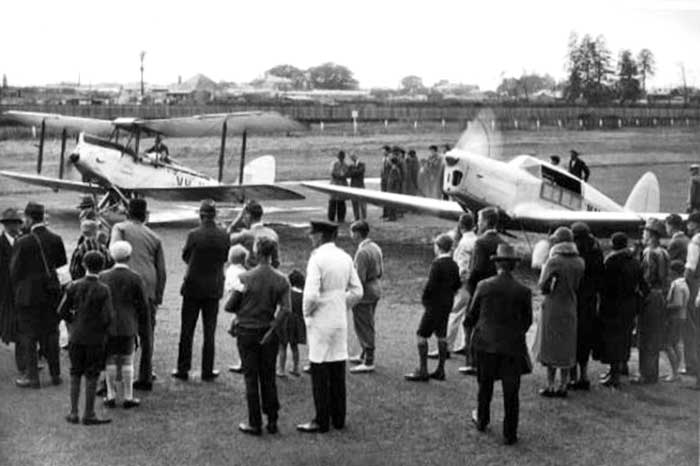
Aerial Survey Expedition to central Australia. Photo: Ed Coates Collection
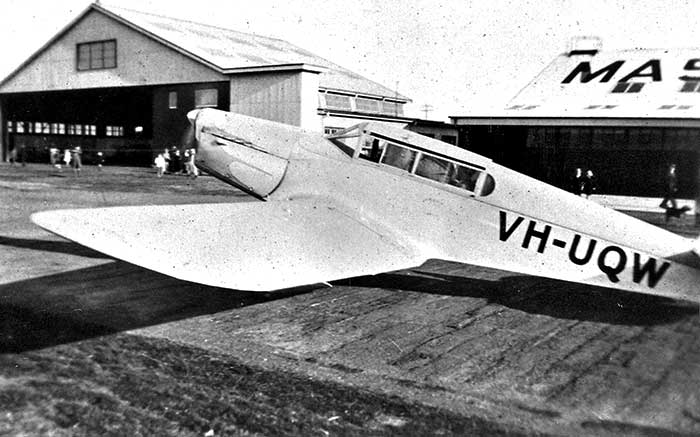

| .33 | Built at Yate Aerodrome, Gloucestershire by George Parnell & Co under contract to Percival Aircraft Co. Model D.2 Gull Four IIA, Gipsy Major |
| 23.9.33 | Registered G-ACJV Sir Charles Edward Kingsford-Smith c/- Kingsford Smith Air Service Ltd, Mascot Aerodrome, Sydney NSW. Base shown as Heston |
| 2.10.33 | British CofA issued. Fitted with a long-range fuel tank in the cabin |
| 4.10.33 | Sir Charles Kingsford-Smith departed Lympne at 5.28am in G-ACJV on record attempt to Australia in Miss Southern Cross. Reached Wyndham WA at 5.15pm on 11.10.35: new record 7 days 4 hrs 47 mins. |
| 16.10.33 | Kingsford Smith tells newspapers he will acquire sole agency for Percival Gull aircraft and possibly supervise their manufacture in Sydney. |
| 16.11.33 | G-ACJV and Fokker VH-USU Southern Cross conducting joyrides
at Nhill Vic. Gull flown by O. B. "Pat" Hall, and the Fokker by Sir Charles Kingsford Smith |
| 18.11.33 | G-ACJV sustained minor damage when it struck a piece of wood in grass on takeoff at Kaniva Vic, pilot Pat Hall. The Gull and Fokker VH-USU were conducting joyrides at Kaniva |
| 25.11.33 | G-ACJV flew a display at the first airshow to be held at Canberra ACT, pilot Pat Hall. Hall then carried numerous customers on short joyrides. |
| 6.12.33 | CAB Inspection Report on G-ACJV at Mascot after overhaul at Mascot. Testflown same day by Sir Charles Kingsford-Smith |
| 8.12.33 | Registered VH-CKS Sir Charles E. Kingsford Smith, Sydney NSW |
| The
sequential allocations at that time were in the VH-UR_ block. CAB
allowed this out-of-sequence registration as a special one-off case | |
| 8.12.33 | Australian CofA issued at Mascot |
| 33-34 | VH-CKS operated on charter flights by Kingsford Smith Air Service Ltd, Mascot |
| 26.12.33 | Damaged at Mascot when the engine was started by an unauthorised person. The throttle was open wide and the aircraft rolled forward and a wing struck a hangar door. |
| 29.12.33 | Repairs completed at Mascot by Tugan Aircraft Co |
| 10.4.34 | Sir Charles Kingsford Smith flew VH-CKS from Mascot to Melbourne to accompany his Codock airliner VH-URP flown by T.W.White, which was to undergo flight trials at Essendon. Both aircraft landed at Goulburn NSW due poor weather. The Codock overnighted at Cootamundra but the Gull continued to Essendon |
| 14.6.34 | Captain P. G. Taylor departed Sydney in VH-CKS for Batavia (now Jakarta, Indonesia) on a charter to collect photographs of the current Ashes Cricket Test Match in England for Australian newspapers, as well as a special air mail delivery from Britain. Both had been flown to Batavia on the scheduled KLM airline service from Holland |
| 21.6.34 | Taylor left Batavia in VH-CKS with the newspaper photographs and airmail, reached Wyndham WA on 22.6.34, and arrived back at Sydney on 24.6.34. The cricket pictures were published in Australian newspapers on 25.6.34. |
| 10.9.34 | Damaged on engine start at Newcastle NSW. Throttle was too far open when started by D.C.Collins, aircraft moved forward and tipped into a concrete drain. No passengers on board. Damage to engine, undercarriage, cowling and propeller. |
| 29.9.34 | Repairs completed by engineer J.T. Pethybridge |
| 5.11.34 | Annual CofA renewed at Mascot. Testflown that day. |
| 19.10.34 | Damaged in forced landing in a field at Coolalie NSW due rough running engine. Undercarriage struck a large rock and the wing struck a tree, substantial damage. Pilot R. G. Whitehead and a passenger |
| 26.11.34 | Departed Mascot for Ceduna SA on a charter to pick up Mr. L.
Hinks who was travelling East from Kalgoorlie as a passenger on a West
Australian Airways Dragon on the Perth-Adelaide service. Hinks was rushing to Sydney due illness in his family. Pilot O. B. "Pat" Hall, a company pilot with Kingsford-Smith Air Service, collected him off the WAA plane at Ceduna and returned him to Sydney |
| 28.11.34 | Crashed, destroyed in mountains near Yerranderie NSW. |
| Pilot O. B. Hall who was seriously hurt and the passenger Hinks died.
While flying Mildura-Sydney, encountered cloud down to hill tops, so Hall climbed to 8,000 feet in cloud then when he calculated he should be crossing the coast and over the sea, let down through cloud. He was however over mountainous country near Picton. When Hall broke through the low cloud he saw a hill right ahead and pancaked into trees. Pat Hall was taken to Camden Hospital. |

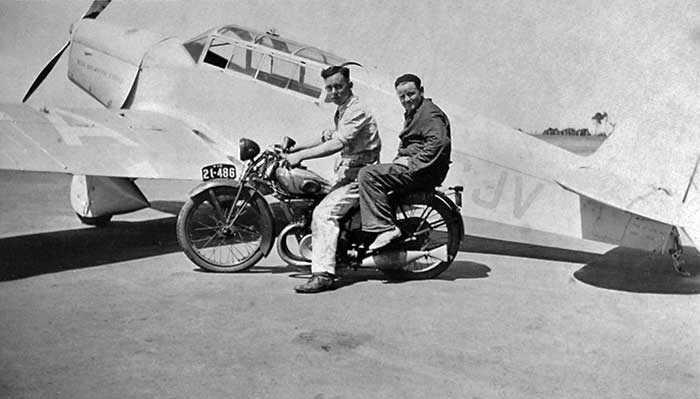

| 7.9.33 | Registered G-ACJW Patrick Randolph, Sherbourne, Dorset |
| 18.9.33 | Built at Yate Aerodrome, Gloucestershire by George Parnell & Co under contract to Percival Aircraft Co. Type D.2 Gull Four IIA, Gipsy Major |
| 23.9.33 | British CofA issued |
| 8-9.34 | Reportedly used by Everson Flying Service, Ireland |
| 11.34 | Struck-off British Register due change of owner |
| Purchased for O.B. Hall by De Havilland Aircraft Pty Ltd, Sydney | |
| Shipped to Australia | |
| 16.1.35 | Civil Aviation Branch allotted registration VH-UTC to Percival Gull previously G-ACJW being imported by De Havilland Aircraft Pty Ltd, Sydney for O. B. Hall |
| 25.1.35 | CAB Inspection Report at Mascot after assembly |
| 26.1.35 | Testflown Mascot by O.B.Hall |
| Hall had been injured in the crash of Percival Gull VH-CKS near Sydney 28 November the previous year | |
| 30.1.35 | Registered VH-UTC Oliver Blythe “Pat” Hall, Sydney NSW Type quoted as D.2 Gull Four IIA, 130hp Gipsy Major |
| 30.1.35 | Australian CofA issued |
| 18.1.36 | CofA renewed at Mascot. Testflown that day by O.B.Hall |
| 18.2.37 | CofA renewed at Mascot. Testflown that day by O.B.Hall |
| 28.2.38 | CofA expired at Mascot. Hall does not intend renewing the CofA, pending selling the aircraft |
| 16.9.38 | CAB Inspection Report at Mascot after a previous defects report had been rectified |
| 28.10.38 | Testflown Mascot by O.B.Hall after overhaul and repairs |
| 29.10.38 | Change of ownership Louis Bernard “Ben” Steinke, Adelaide SA |
| c11.38 | VH-UTC collected at Essendon for Steinke by Adelaide pilot Bill
Maddocks, who flew it to Parafield. He landed at Murray Bridge SA to pick up the owner for thre last leg to Parafield. Based at Parafield, maintained by MacRobertson Miller Aviation Co. |
| 7.6.39 | Change of ownership: David Smyth, Sydney NSW |
| 8.6.39 | Departed Parafield on delivery to Sydney |
| 27.9.39 | DCA memo: Mr Smyth left for Britain some months ago. Before he left he authorised Airflite Ltd at Mascot to house VH-UTC and attenmpt to sell it |
| 1.11.39 | CofA renewed at Mascot, testflown that day by Pilot N. Clarke |
| 5.1.40 | Change of ownership: John C. D. Whitty, Longreach Qld |
| 5.1.40 | DCA Inspection Report at Mascot: aircraft is maintained in good condition |
| 28.7.40 | Crashed during landing at night Longreach Qld. Pilot J. C. D. Whitty was undertaking night flying and landing practice with the aerodrome lighting activated. Aircraft struck telephone wires, undercarriage torn off and aircraft struck the ground on its belly, substantial damage to fuselage. Pilot and passenger unhurt. |
| 7.40 | Wreck moved to Qantas Empire Airways workshop at Longreach Aerodrome |
| DCA accident investigation challenges whether the aerodrome lighting was in fact operating but unable to confirm. Whitty conducts regular joyriding in the Longreach district. | |
| 45-46 | No reply from Whitty to letters from DCA asking his intentions re rebuilding the aircraft |
| 31.1.46 | Struck-off Register |
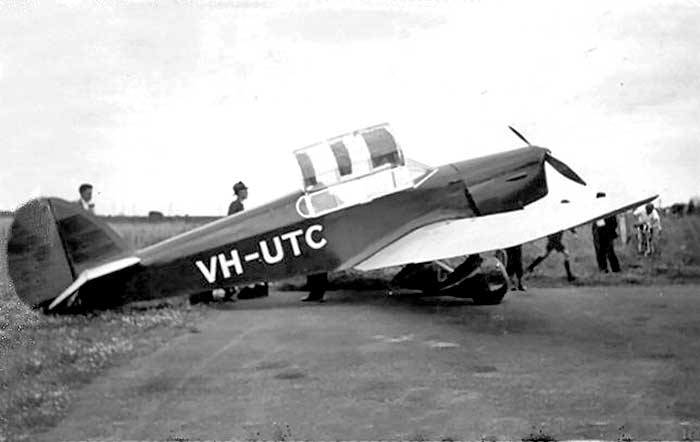
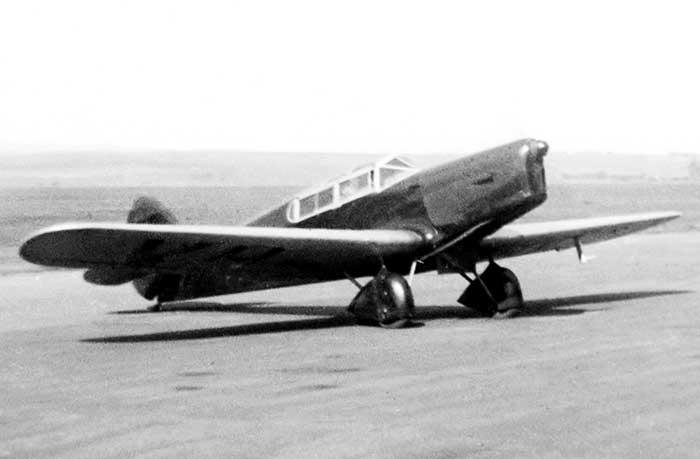
| .33 | Built at Yate Aerodrome, Gloucestershire by George Parnell & Co under contract to Percival Aircraft Co. Model D.2 Gull Four II with 160hp Napier Javelin III engine. This was the 10th Gull built. |
| 17.6.33 | First flight Yate |
| 17.6.33 | Registered G-ACHA Edgar W. Percival, Yate |
| 17.6.33 | 1CofA issued |
| 8.7.33 | Flown in Kings Cup Air Race by Edgar Percival, as Race #11 |
| 25.7.33 | Change of ownership: Airwork Ltd, Heston, based at Manchester-Barton |
| 34 | Re-engined with 130hp DH Gipsy Major, which made it equivalent to a D.3 Gull Six. However the modifications did not include the Gull Six design undercarriage and cockpit canopy |
| .35 | Sold to P. G. Taylor, Sydney. Taylor was now the Percival agent for Australia. |
| Shipped to Australia | |
| 28.5.35 | CAB Inspection Report after assembly at Mascot Aerodrome, Sydney |
| 28.5.35 | Australian Registration application: P. G. Taylor, Sydney. |
| 9.6.35 | Registered VH-UTP Patrick G. Taylor, Sydney. Type quoted as D.3 Gull Six, 130hp Gipsy Major |
| 9.6.35 | Australian CofA issued |
| Flown by Captain P. G. "Bill" Taylor. Aircraft nasmed Polaris | |
| 10.8.35 | Delivered to Essendon on sale to Victorian Flying School & Taxi Service Pty Ltd, Melbourne-Essendon. |
| 16.9.35 | Meeting of shareholders agreed to liquidation of VFS&TS, and formation of new company named Chaseling Air Services registered 13.9.35. Chief pilot Eric Chaseling |
| 10.35 | UTP flew Essendon-Sydney-Tennant Creek NT-Sydney-Essendon, pilot Gordon Cameron. Charter flight arranged by Captain P. G. Taylor, the previous owner of the Gull |
| 26.10.35 | flew a charter from Essendon to Donald Vic and return, pilot Gordon Cameron |
| 12.35 | Change of ownership: Holyman’s Airways Pty Ltd, Launceston Tasmania. Civil Register quotes date to Holyman’s Airways as 1.4.36 |
| Named Pinega | |
| 1.11.36 | Change of ownership due merger: Australian National Airways Pty Ltd, Melbourne-Essendon |
| 13.5.38 | Damaged landing at Cowell SA while carrying spare parts to ANA DC-2 VH-USY Bungana grounded at Ceduna SA. The Gull suffered a collapsed undercarriage and broken propeller, pilot W. P. Heath |
| 28.3.40 | Engine backfired on start at Parafield SA, igniting fabric under wing. The fire spread to the starboard wing before being extinguished. Aircraft was undergoing CofA renewal at the time and the engine was started by two company engineers, no pilot present. |
| 2.10.40 | Memo from DCA Parafield: Gull UTP has been inspected: it has not yet been repaired after a recent fire, fabric under fuselage is burnt away. |
| 29.1.41 | CofA renewed at Parafield after fire damage repaired |
| 24.4.42 | Director General of Civil
Aviation letter to Department
of Air, in response to enquiry concerning availability of civil
aircraft
which could be impressed for RAAF communications use by Western
Command: the list of available aircraft included VH-UTP owned by ANA. |
| 10.6.42 | CofA renewed at Parafield |
| 27.7.43 | Roy Edwards, Darwin wrote to DCA from Parafield: he has inspected VH-UTP
and requests approval under wartime civil aviation restrictions to purchase it from ANA
and requests the issue of fuel ration allowance to ferry it to Alice Springs NT. Approved by DCA. |
| 1.8.43 | Letter from Allied Works Council: considered highly desirable that Edwards brings a Percival Gull to Alice Springs where it can be used on urgent wartime construction work by AWC |
| 16.8.43 | CofA renewed by ANA at Parafield |
| 24.8.43 | Change of ownership: Roy M. Edwards, Darwin NT |
| 9.43 | Edwards was delayed in Adelaide for six weeks due contracting
severe measles. He chartered VH-UTP to Guinea Airways at Parafield who used it to replace their DH.83 Fox Moth VH-UTY on their scheduled services from Adelaide to Port Pirie and Whyalla SA |
| 26.10.43 | UTP returned to Parafield after departure due u/s airspeed indicator. Pilot W. J. Small, operator Guinea Airways |
| 15.8.44 | Annual CofA
expired. Ferried from Alice Springs to Parafield
later that month by Edwards after the aircraft was signed out by Connellan
Airways engineer Harry Moss as fit for ferry flight. CofA renewed at Parafield |
| 22.4.46 | Guinea Airways DC-3 Captain N. S. Buckley log: Parafield local flight: endorsement on Gull |
| 24-26.4.46 | Captain N.S.Buckley log: Parafield-Alice Springs-Harts Range-Alice Springs. |
| 27.4.46 | Captain N.S.Buckley log: Alice Springs-Harts Range-Alice Spprings |
| 8-13.5.46 | Captain N.S.Buckley log: Alice Springs-Harts Range-Alice Springs, daily return flights |
| 14.5.46 | Captain N.S.Buckley log: Alice Springs-Tennant Creek-Katherine-Darwin |
| 5.12.46 | CofA expired at Darwin |
| 27.3.47 | DCA Memo: UTP is undergoing CofA renewal overhaul at Darwin |
| 17.6.47 | Change of ownership: Henry V. Moss, Darwin NT |
| On the same day Harry Moss also purchased Roy Edwards' DH.83 Fox
Moth VH-UTF and used it for extensive charter flying from Darwin. Moss
later wrote in his book 10,000 Hours: "My newly acquired Fox Moth, a biplane with a 130hp Gipsy major engine, had a cabin to seat four passengers. It was ideally suited to my work. The other aeroplane, a Percival Gull, also fitted with a Gipsy Major had begun its career in England on a service from Ringway to the Isle of Man. It was a good long range aeroplane, but the all-wood glued construction made it too difficult to maintain in a tropical climate, and it had to be flown carefully in the heat of the day." | |
| 18.7.47 | Change of ownership: Salvation Army Property Trust, Melbourne, Vic c/- Captain Victor Pederson. Based Darwin. |
| 11.9.47 |
Ground-loop during landing, Darwin. Undercarriage broken away, port wing main spar damaged. |
| c48 | Blew the port tyre on takeoff Wave Hill NT. Pilot Salvation Army Captain Victor Pedersen had achieved flying speed so continued to Limbunya where he landed and kept the weight on the good tyre until the port wing lost airspeed and dropped. UTP came to a stop facing across the runway but Pedersen carried a spare tyre and tube and quickly repaired the aircraft |
| 10.2.49 | Captain Pedersen agreed to fly urgent supplies and a local
farmer to Daly River settlement, to land on a clear area on a peanut
farm. But the surface was soft due recent rain, and undercarriage sank and was
ripped away, the aircraft came to rest on its belly and the
propeller damaged. No injuries. Pedersen wanted the aircraft moved across the adjacent Daly River before its level rose too high. Wings were removed, fuselage with engine lifted by men on to a wagon which was then towed across the river and left at the police station. Semi trailer arrived from Darwin 13.2.49 to collect the aircraft, heavy rains caused 16 running creek crossings each direction. The rain continued so it was decided to leave the aircraft loaded on the truck trailer at Daly River, while the driver and Pedersen left in the prime mover to negotiate the flooded rivers back to Darwin. Aircraft collected when rains abated and roads became passable. |
| 49 | UTP left dismantled in hangar at Darwin Airport. Pederson used a DH.82 loaned by Ben Hingston |
| c50 | UTP repaired and testflown at Darwin by Victor Pedersen. |
| 17.4.51 | Change of ownership: Keith S. Mullan, c/- Qantas Empire Airways, Darwin NT |
| 7.5.51 | Struck-off Register due withdrawn from service |
| 21.9.51 | Registration application: K.S.Mullan, Darwin. He advises DCA that the aircraft has been on overhaul for the past 12 months due difficulty in obtaining necessary parts. Expects it to be completed 10.51 |
| 15.10.51 | Testflown Darwin after extended overhaul |
| 15.10.51 | Restored to Register Keith S. Mullan, Darwin NT, later Raleigh NSW |
| 15.10.51 | CofA renewed at Darwin |
| 28.1.53 | Annual CofA renewal at Darwin |
| 5.53 | Airframe Log: Flown to Bankstown, apparently from Alice Springs |
| 6.53 | Log: Flown Bankstown-Coffs Harbour NSW |
| 7.53 | Mullan advises DCA his address has changed from Darwin to Raleigh NSW. He is employed by Amalgamated Wireless Australia as a radio technician at Sydney Airport |
| 9.11.53 | Log: Departed Coffs Harbour for Port Moresby, New Guinea (delivery flight to Goilala Air Service) |
| 2.4.54 | Change of ownership: Goilala Air Service, Tapini, New Guinea |
| 5.7.54 | Forced landing due weather at Iron Range Qld while being
flown from New Guinea to Sydney by Laurie Crowley (proprietor of
Crowley Airways, Lae) to take part in the REDeX Air Trial. Located by a
searching RAAF Lincoln bomber from RAAF Townsville. Crowley had originally entered his Stinson L-5 VH-CSA but changed his entry to the much faster Gull which he borrowed from Ernie Reid of Goilala Air Service |
| 1.8.54 | Departed Bankstown as competitor in 1954 REDeX Navigation and
Reliability Trial, flown by Laurie Crowley and Bill Englebaeck, a pilot with Mandated Airlines in New Guinea. Air Trial route was Sydney-Brisbane-Townsville-Darwin-Alice Springs-Adelaide-Wagga-Sydney |
| 3.8.54 | Rockhampton Morning Bulletin newspaper report: “A red single engined Percival Gull, formerly reported missing north of Cooktown while on its way from New Guinea to enter the trial, was the second plane to land at Rockhampton yesterday. Flown by Mr. L. Crowley who runs an airline service at Lae, this machine was formerly owned by the Salvation Army and based at Darwin.” |
| 12.8.54 | Forced
landing in flat desert country near William Creek SA, 1,000 KM north of
Adelaide, during the Air Trial. Cowley and Englebach made a camp
alongside the aircraft, while Cowley worked on the engine. They were located by other air trial aircraft and Crowley flew the Gull out several days later |
| 54 | Returned to New Guinea to charter flying with Goilala Air Service |
| 8.3.56 | Change of ownership: Australian Aircraft Sales, 40 Darlinghurst Rd, Kings Cross, Sydney |
| 7.5.56 | Change of ownership: Rain Air Taxis c/- AAS, Sydney. Based at Bourke NSW |
| 9.5.56 | Damaged in ground-loop at Bourke NSW Location also quoted as Camden NSW and date as 19.5.56: not listed in 1956 DCA Accident summary. |
| This was VH-UTP's last flight for 43 years | |
| 4.57 | Advertisement in Aircraft magazine 4.57: "Australian Aircraft Sales, Hangar 58 Camden Aerodrome. Head Office 40 Darlinghurst Road, Kings Cross: Vega Gull, port wing damaged and starboard undercarriage: best offer” |
| 30.6.59 | Struck-off Register |
| Damaged
airframe stored in hangar at Camden Airport NSW, owned by Laurie
Johnson, who was proprietor of Rain Air Taxis. By mid 1960s the
Gull was stored by Harold Thomas at his Camden Museum of Aviation,
owner was still Laurie Johnson | |
| 20.9.65 | Gull forward fuselage noted in hangar at Camden: cockpit canopy windows complete |
| 7.73 | Reported stored at Bargo NSW, in open weather on farm owned by Laurie Johnson Purchased as restoration project by John Hill, Brisbane Qld |
| .78 | Acquired by Don Johnson, Brisbane Qld. He had originally been a partner with John Hill in the Gull project, but now took it over and moved it to Queensland |
| 12.78 | Trucked from Bargo to Don Johnson's property at Bahr's Scrub, Queensland
where restoration process was commenced |
| 86 | VH-UTP's derelict fuselage and wings stored in Don Johnston's
workshop at Beenleigh Qld. In the same workshop are the remains of Vega Gull VH-BQA Don Johnson later wrote: “The two aircraft VH-UTP and VH-BQA are only connected by the fact that they were both stored at my property for some time. Great care was taken to keep parts from both aircraft separated. VH-BQA is the subject of another restoration” |
| 20.10.89 | VH-UTP’s remains arrived at Murwillumbah NSW by road for an airworthy restoration by Challinor Brothers trading as MothCair Aviation |
| 1.9.91 | noted at Murwillumbah NSW under rebuild |
| 12.93 | Both wooden mainplanes constructed but uncovered have been attached to fuselage at Murwillumbah by MothCair Aviation |
| 10.96 | Report: fuselage almost completed at MothCair Aviation Services, Murwillumbah airfield NSW: standing on its wheels, painted red with white flash and large fuselage registration |
| 13.10.98 |
noted at Murwillumbah nearly completed rebuild by Challinor
Brothers. MothCair report at that time stated the Gull was being rebuilt for Don Johnston, a Singapore Airlines pilot, and that “very little of the original structure was used” |
| 29.8.99 | Restored to Register as VH-UTP Donald Johnston, Bahrs Scrub Qld |
| 21.10.99 | First flight Murwillumbah, pilot Steve Marchesi |
| 27.8.00 | visited flyin at Watts Bridge Qld |
| Remnants of the original derelict airframe, which were too deteriorated, to be used in the rebuild, including a fuselage section and portions of the wing and wing spar, were donated by John Hill to Queensland Air Museum. Displayed inside QAM Hangar 2 at Caloundra. | |
| 4.02 | Restored Percival Gulls VH-UTP & -CCM flew from their Murwillumbah base to Watts Bridge Qld flyin |
| 8.06 | VH-UTP & -CCM visited Watts Bridge Qld flyin, parked together. Also 8.08 |
| 23.9.10 | VH-UTP noted at Murwillumbah NSW, in hangar. Based here owned by retired airline pilot Don Johnston. Gipsy Major engine |
| Current |
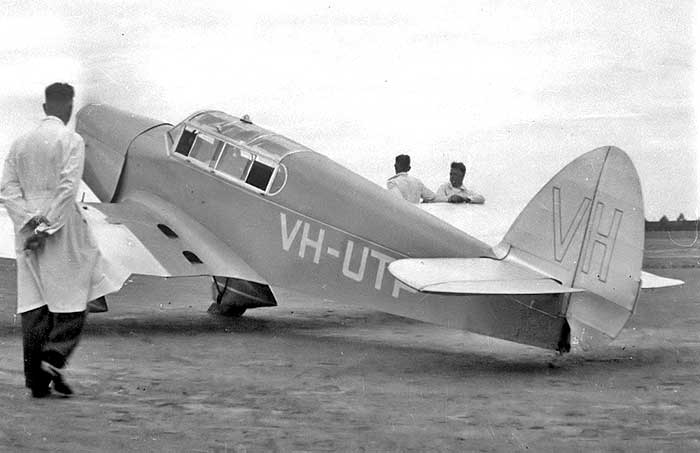
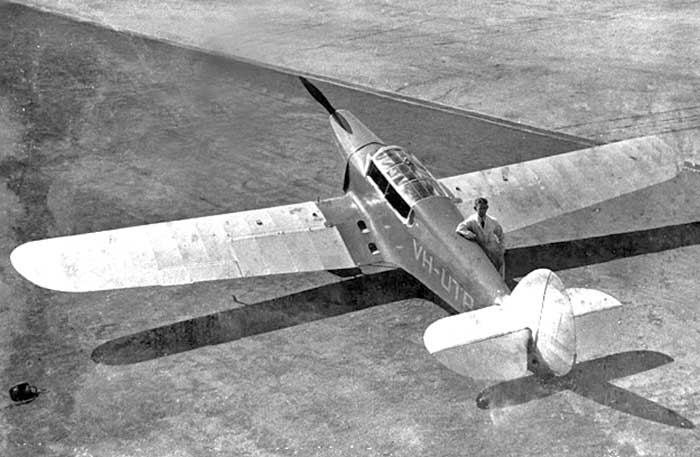
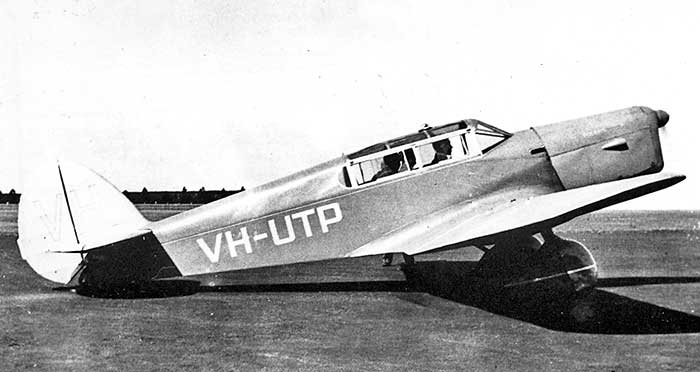

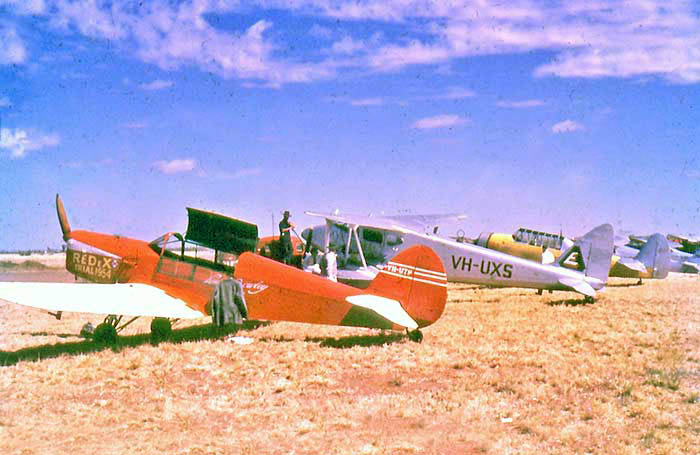
Engine trouble forced V H-UTP down in desert country near William Creek SA during the trial, August 1954
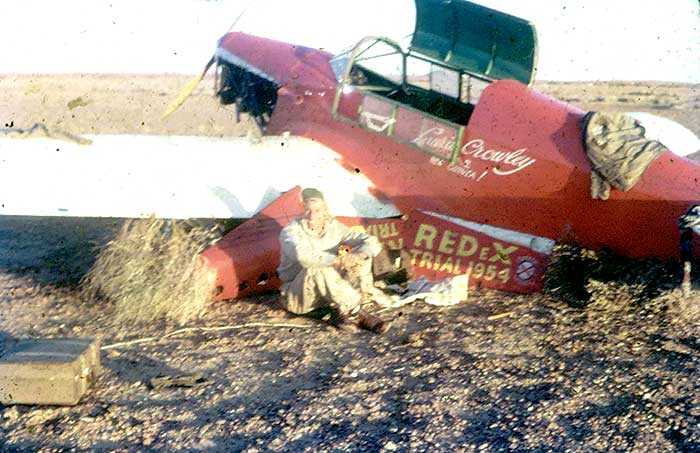
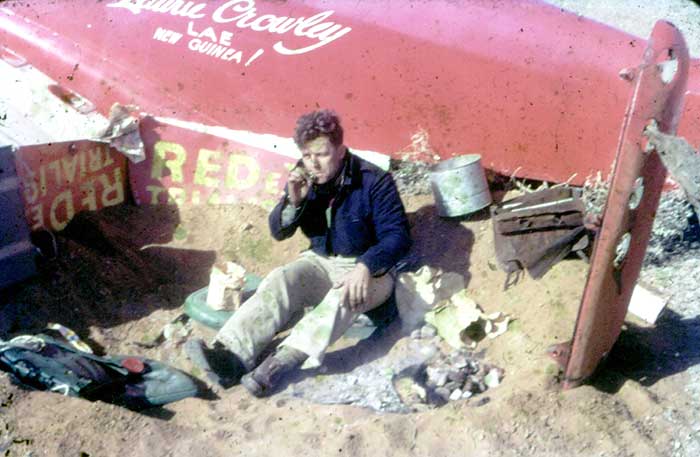
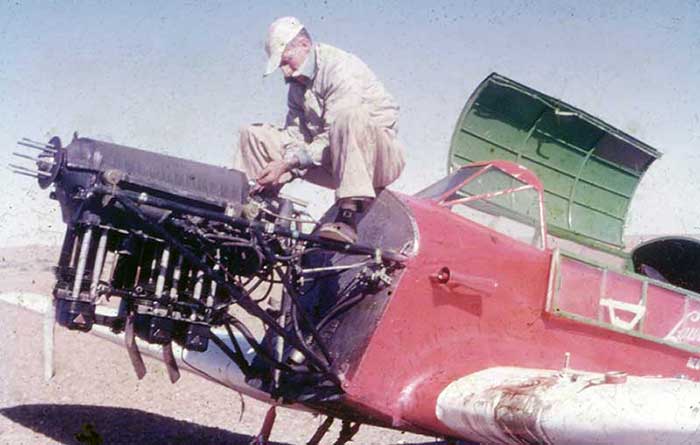
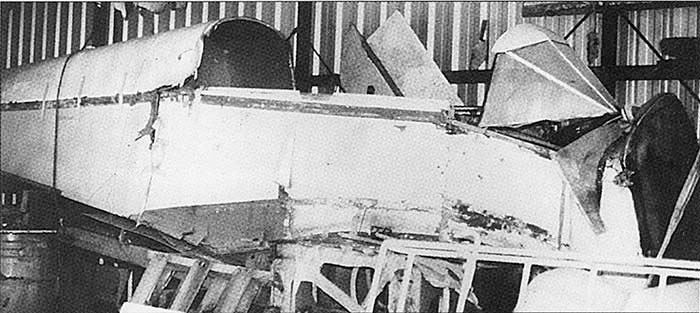
Photo by Graham Orphan
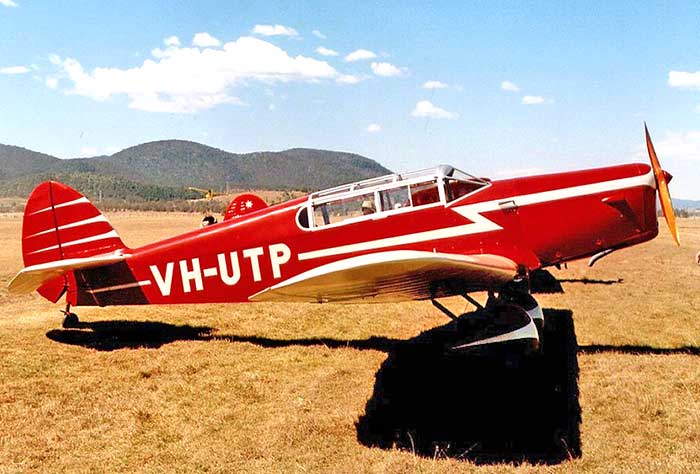
Seen visiting a fly-in at Watts Bridge Qld in August 2008. Photo by Bert van Drunick
| .35 | Built at Gravesend by Percival Aircraft Ltd. Production Type D.2 Gull Four, DH Gipsy Major |
| .35 | Australian CAA allocated registration VH-UVH, whch was painted on the aircraft at the factory. Colour scheme was silver and olive green |
| 29.8.35 | British CofA issued as VH-UVH Charles James Melrose, Gravesend James "Jimmy" Melrose lived in Adelaide, South Australia. He become a popular public figure after flying his DH.80 Puss Moth VH-UOO solo in the previous year's MacRobertson Air Race from London to Melbourne. During January 1935 he flew the Puss Moth from Adelaide to Sydney where he sold it to fellow long-distance flier H.F.Broadbent then sailed to England to purchase a higher performance Percival Gull. On arrival in Engand Melrose attended a pilot training course at Air Service Training in aerial navigation techniques and flotaplane handlang (he planned to start a floatplane air service from Adelaide to Kangaroo Island and Port Lincoln) |
| 6-7.9.35 | Melrose flew the Gull in the 1935 Kings Cup Air Race as race #31. He was placed 12th at average speed 143.97mph. When Alex Henshaw's Gull force landed in water along the course, Melrose circled until Henshaw was picked up by a passing Isle of Man steamer, Melrose thereby losing any chance of winning |
| 2.11.35 | Melrose departed Croydon Aerodrome, London at 7am on record flight to Australia. The Gull had been named Westley after his mother’s middle name. H.F."Jimmy" Broadbent in Gull VH-UVA departed at the same time Sir Charles Kingsford Smith in the Lockheed Altair VH-USB overflew Melrose over Siam, making Melrose the last person to see the Altair which was posted missing the same day. On arrival Singapore Melrose learnt that the Altair was missing, so abandoned his record attempt to Australia and took part in an aerial search for the next 5 days. |
| 12.11.35 | Melrose made forced landing due engine failure on a beach
at Tako, Siam while on the search. Aircraft tipped on its nose in the
surf. Pulled out of water by local native fishermen. The engine had a
piston failure, and the propeller was bent. With help from villagers, Melrose reached Penang on the Bangkok-Penang train. The Penang Flying Club flew him back to Tako with a mechanic and spare parts. After a week VH-UVH was repaired and Melrose took off from the beach and flew to Penang, where it was given an overhaul |
| 25.11.35 | Melrose departed Singapore for Australia after resting and the having the Gull inspected by RAF. |
| 28.11.35 | Arrived Darwin at 4.45pm. 26 days after leaving England |
| 30.11.35 | Arrived Parafield Aerodrome, Adelaide at 10am. |
| 30.11.35 | After refuelling, Melrose departed Adelaide on the same
day, flying to Melbourne. Circled his mother's home in Glenelg on
departure. While in Singapore he had received a cable with a business
deal to deliver the photographs and movie film he took during the
search for Kingsford-Smith to Melbourne within a week. One of his
photographs was published in a Melbourne evening newspaper that same
day. VH-UVH was parked at Essendon Aerodrome, where it was placed on public view |
| 3.12.35 | Melrose departed Essendon at 9.30am, landed at Cootamundra to refuel. Then departed for Sydney. Encountered low cloud and rain in the Goulburn area |
| 3.12.35 | Crashed during a forced landing at Penrose, near Bundanoon, near Goulburn NSW. The Gull struck a tree stump, and swung the aircraft, one wing torn off and fuselage broken. James Melrose was taken to Bowral Hospital with cuts and severe sprains to his feet and ankles. Jim Broadbent was an early visitor Melrose later wrote in his diary: "It's remarkable I was not hurt more, for the Gull was broken in two. The engine went out sideways to the right, and there was nothing in front of me. The right wing was completely smashed, whilst the left wing was not quite so bad. The propeller went to bits and the undercarriage came through the tanks. The last time Westley will ever fly." |
| 12.35 | Broadbent on Melrose' behalf made the arrangements to have the wreck moved to Mascot Aerodrome, Sydney where it was placed in the De Havilland Aircraft hangar |
| 12.12.35 | Broadbent flew Melrose to Sydney.
After landing at Mascot, Broadbent carried the injured Melrose on his back to the
hangar so he could inspect the wreck of the Gull. Melrose made a good recovery and in January 1936 sailed to Engand to purchase a new Heston Phoenix. |
| 21.5.36 | CAB Memo from Mascot office: refers to the tailwheel design of the dismantled Gull VH-UVH owned by Mr. Melrose. |
| 5.7.36 | James Melrose, aged 26 years, was killed in crash of his Heston Phoenix VH-AJM near Melton Vic. |
| 10.8.36 | CAB Head Office Melbourne sent a minute to CAB Sydney office:
“Re Gull flown from UK by the late C. J. Melrose. Tentative markings VH-UVH displayed on this machine, an application for registration was not submitted before the machine suffered damage in an accident. Currently in a crashed condition with De Havilland Aircraft Pty Ltd, Mascot. Advise D.H. that markings have been withdrawn.” |
| Gull not rebuilt | |
| 12.36 | Registration VH-UVH was re-allocated to a newly imported Porterfield |
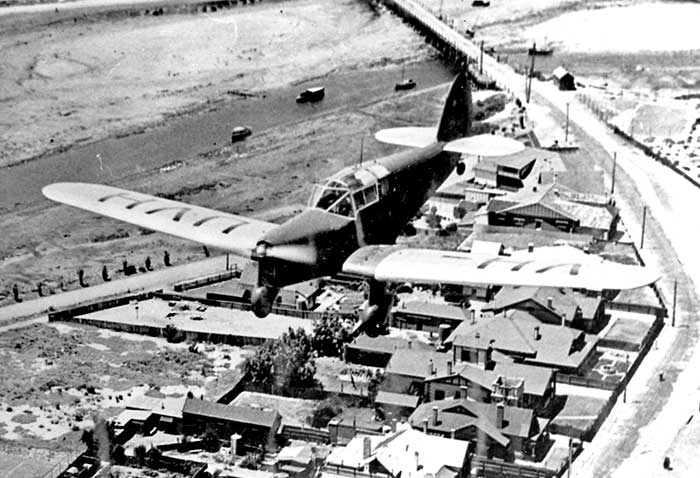
He was departing Adelaide for Melbourne, only hours after reaching Adelaide from England.
Photo: John Hopton Collection
| .35 | Built at Gravesend by Percival Aircraft Ltd. Type D.3 Gull Six, 200hp DH Gipsy Six engine |
| Ordered by P. G. Taylor, Sydney who took over from Charles Kingsford-Smith as Percival agent for Australia | |
| .35 | Australian CAA allocated registration VH-UVA, whch was painted on the aircraft at the factory |
| 22.10.35 | British CofA issued as VH-UVA: Kingsford-Smith Air Service Ltd, Mascot Aerodrome, Sydney |
| 2.11.35 | Record-breaking Australian pilot H.F. “Jimmy” Broadbent departed Croydon Aerodrome, London at 7am. He hoped to break the England-Australian flight time record while delivering VH-UVA to P. G. Taylor. C.J. "Jimmy" Melrose departed at the same time in his Gull VH-UVH, both men attempting individual record flights |
| 9.11.35 | Broadbent arrived Darwin NT at 1.49pm, breaking the record |
| 11.35 | Long
range fuel tank hastily removed from VH-UVA at Mascot and
installed in the cabin of Tugan Gannet VH-UUZ by Harry Purvis. The
Gannet had been chartered by the Kingsford-Smith Search Committee to
join the search for Sir Charles Kingsford-Smith and Tommy Pethybridge
who had failed to reach Singapore on 8.11.35 while making a speed
record attempt England-Australia in Lockheed Altair G-ADUS Lady
Southern Cross. Captain P. G. Taylor and Harry Purvis departed
Sydney in VH-UUZ 15.11.35 for Singapore, but while outbound to Darwin, Taylor fell ill and the search flight was abandoned |
| 22.1.36 | VH-UVA Inspection Report at Mascot, signed by P.G. Taylor as owner. The auxiliary fuel tank and fittings in the cabin have been removed by De Havilland Aircraft Pty Ltd at Mascot and two passenger seats installed |
| 22.1.36 | Registration application: Patrick Gordon Taylor, Sydney CAB advise Taylor that CofA will be delayed pending receipt of suitable drawings for the installation of an additional oil tank by Tugan Aircraft Co at Mascot and flight testing. High oil temperatures had been experienced by Broadbent while flying in hot weather in central Australia on the delivery flight |
| 4.2.36 | Registered VH-UVA Patrick Gordon Taylor, Sydney NSW Type quoted as D.3 Gull Six, 200hp Gipsy Six |
| 12.3.36 | CofA issued by CAB upon receipt of drawings and advice that flight tests showed oil temperature had dropped 12 degrees with the additional tank installed |
| 15.5.36 | CAB Head Office memo to CAB Sydney office: during a recent visit to Essendon, VH-UVA was seen
to be fitted with a tailwheel instead of tailskid, and the tailwheel design
was considered unsatisfactory. CAB Mascot were instructed to investigate. Their reply to Head Office states the tailwheel is the standard Percival design, fitted to the aircraft for the delivery flight and is identical to that on the dismantled VH-UVH owned by Mr. Melrose. No response from Head Office |
| 3.11.36 | Minor damage on landing Coffs Harbour NSW, pilot Taylor while transporting packages from Melbourne to Brisbane. His accident report blames the poor surface of the aerodrome. Tailwheel and port undercarriage fairing damaged. Repairs completed 13.11.36 by De Havilland Aircraft Pty Ltd, Mascot and parts by Qantas. |
| 18.12.36 | Captain P. G. Taylor flew VH-UVA on charter to
Sydney Morning Herald newspaper to cover the Brisbane-Adelaide
Centenary Air Race, arrived with competitors at a scheduled stop at
Nhill Vic. Newspaper reported a near collision between Taylor's Gull and DH.60G VH-UGV and BK Eagle VH-USI on final approach at Nhill |
| 19.2.37 | CAB inspection report at Mascot |
| 14.3.37 | Damaged while taxying at Condobolin NSW, pilot Taylor. He had landed to refuel while enroute Sydney to Broken Hill. His accident report blames the poor condition of the aerodrome surface |
| 7.4.37 | Repairs completed |
| 12.5.37 | P. G. Taylor departed Sydney in his blue Percival VH-UVA for Batavia (now Jakarta, Indonesia) on a charter to collect photographs of the Coronation of King George VI for Australian newspapers. He refuelled at Cloncurry, Camooweal, Daly Waters, Darwin, Koepang, Rambang and Sourabaya, arriving Batavia on 18.5.37. |
| 19.5.37 | Taylor departed Batavia with the newspaper photographs, reached Wyndham WA on 20.5.37, reportedly breaking the solo pilot Java-Australia speed record. Delayed at Broken Hill NSW on the final leg of the flight, and he finally returned to Sydney on 26.5.37 |
| 18.10.37 | Change of ownership: George E. Ryder, Cessnock NSW. To be based Newcastle |
| 1.4.38 | Inspection Report at Mascot |
| 25.5.38 | CAB inspection report at Newcastle. Good condition. TT 516 hrs |
| 11.3.39 | Annual CofA expired. Parked in a hangar at Newcastle, where the aircraft was
maintained by Newcastle Aero Club. Owner requests approval to ferry
aircraft to Mascot for CofA renewal overhaul. DCA approve ferry Newcastle-Mascot. |
| 4.4.39 | Testflown Mascot after CofA renewal, pilot W.A. Hancock (DH.90 pilot for North-Western Airlines, Moree) |
| 19.4.39 | Change of ownership: Edward J. Connellan, Alice Springs NT Aircraft painted dark blue, named Jan II on the cowling. |
| This Gull was the first
aircraft for the Alice Springs scheduled air service which was called
Inland Airways at first, then Connellan Airways, and much later renamed Connair | |
| E. J. Connellan wrote in his book Failure of Triumph: "I bought the Percival Gull 6 VH-UVA from P.G. "Bill" Taylor, through a Mr. Riley (sic). Jimmy Broadbent had used this aircraft to make a record flight England to Australia. Taylor had also used it for many record breaking flights, including flying photographs of King George V's coronation from Singapore to Melbourne and later flying photographs of test matches from one city to another throughout Australia at night, for publication in the morning papers." | |
| 4.39 | Stretcher fittings installed at Mascot by De Havilland Aircraft Pty Ltd. |
| 6.39 | Eddie Connellan collected UVA at Mascot. No dual controls were fitted, so
after a demonstration flight by Pat Hall, Connellan flew circuits at
Mascot as his endorsement |
| 13.6.39 | Connellan departed Mascot for Essendon. Fog forced return to Seymour to land overnight, he continued next day to Essendon |
| 1.7.39 | Departed Essendon on
delivery flight to Alice Springs, after a 3 day delay due poor weather.
Flown by Connellan, with his newly-employed first pilot/engineer John
P. Kellow.
Night stop at a farm at Murrayville Vic to collect Kellow's wife, next night at Broken Hill where tailwheel fork was found to be bent and was repaired. Next night stop at William Creek to allow Mrs. Kellow to recovery from severe airsickness |
| 4.7.39 | Arrived at Alice Springs, via a refuelling stop at Oodnadatta SA |
| 10.7.39 | Connellan and Kellow departed Alice Springs in VH-UVA on a trial run along the planned regular air route between Alice Springs and Wyndham WA, with stops at Mount Doreen, The Granites, Tanami, Nicholson Station, Inverway Station, Victoria River Downs Station, Auverne Station and Carlton Station |
| 10.7.39 | This date is also recorded as the inaugural emergency flight
for the newly established Alice Springs base for Australian Aerial
Medical Services (predecessor of Flying Doctor Service of Australia): E. J. Connellan flew brought a doctor from Alice Springs to Hermannsburg Mission for an ill patient. Connellan had a contract with AAMS requiring Connellan t/a Inland Airways to an aircraft and pilot available at all times. Over following years, Connellan used his Percival Gulls, Hawk Moth, Connellan had a contract with AAMS requiring Connellan t/a Inland Airways to have one aircraft and a pilot available at all times. Over following years, Connellan used his Percival Gulls, DH.75 Hawk Moth, DH.82 Tiger Moths with stretchers, DH.84, DH.89, DH.90 and an Auster for the FDS contract |
| 14.7.39 | VH-UVA returned to Alice Springs from the first trial run to Wyndham |
| 7.39 | Conducted joy rides at Alice Springs to raise funds for the new air service |
| 8.8.39 | John Kellow in UVA departed Alice Springs at 7.30AM on the inaugural
scheduled mail run along the route to Wyndham. Returned to Alice
Springs 11.8.39 |
| 12.8.39 | Alice Springs-Tenant Creek-Alice Springs medical flight with Dr. Reilly, pilot Kellow |
| 20.10.39 | Ground-loop on landing at Tanami NT on the scheduled service,
ran off strip. Pilot John Kellow. One undercarriage leg was bent and wingtip scraped the ground. Rough repairs to the undercarriage on site using the mine manager’s workshop tools and oxy-acetylene equipment. The aircraft was jacked up on 44 gallon drums and port wing removed. Kellow repaired the wingtip using fabric and dope from his emergency repair kit. |
| 23.10.39 | Ferried Tanami-Alice Springs direct by Kellow, 3 hrs 20 minutes. |
| 30.10.39 | AAMS flight: Alice Springs-Oodnadatta SA and return to collect a patient, pilot Kellow |
| 31.10.39 | Departed Alice Springs on scheduled mail service to Wyndham, pilot Kellow. On arrival at Tanami. a fuel leak was seen from the port wing tank. With mine manager’s help, the port wing was removed and a bronze welding repair fixed the leak |
| 21.12.39 | Landed safely at Victoria River Downs after engine failed
inbound from Inverway, on the Alice Springs-Wyndham air mail service.
Pilot J. P. Kellow, The engine had exhaust valve and piston damage. No spare engine was held, so the Gipsy VI was removed from VH-ACM at Alice Springs and loaded in Eddie Connellan’s Rolls Royce Tourer, which was driven 700 miles from Alice Springs to VRD, arriving 27.12 after delays winching the vehicle across flooding rivers. The vehicle left for Alice Springs the same day, carrying the damaged engine. Kellow was left to install the replacement engine at VRD. He departed on 29.12.39 to complete the mail run to Wyndham and return. |
| 30.12.39 | VH-UVA returned to Alice Springs. ACM’s engine was then removed and re-installed in ACM. The damaged engine was sent to De Havilland Aircraft Pty Ltd at Mascot for repair. There was a lengthy delay in completion, resulting in UVA being grounded for all 1940. Connellan threatened legal action against De Havilland. Miles Falcon VH-AAS arrived in March 1940 as a replacement. |
| 3.4.40 | Annual CofA expired |
| 21.4.40 | Letter from E. J. Connellan to DCA states that the complete undercarriage of UVA has been fitted to Gull VH-ACM. When UVA completes it engine overhaul, it will be fitted with a new Proctor type undercarriage set, shipped from England by aviation agency W.S.Shackleton Ltd |
| 22.12.40 | Airframe inspection report by CAB Inspector at Alice Springs while engine removed for overhaul |
| 7.1.41 | Testflown Alice Springs by E. J. Connellan after CofA renewal. Repainted all white. |
| 8-11.1.41 | VH-UVA flew the scheduled service from Alice to Wyndham and return |
| 27.3.41 |
Testflown Alice Springs by Connellan after airframe modifications |
| 14.3.42 | CofA renewed at Parafield by Guinea Airways. It had been painted in camouflage on DCA instruction |
| 16.3.42 | Ferried from Parafield to Alice Springs by Jack P. Kellow who had
flown for Connellan 1939-40 and was now CFI at Spencers Gulf Aero Club
at Whyalla. He later wrote: "I received a call from Eddie for assistance. The Gull UVA had been sent down to Guinea Airways workshops in Adelaide for overhaul, and it was then completed and ready for delivery. Eddie asked if it would be possible for me to pick it up in Adelaide, fly it to Alice and then fly one mail run in it for him. I agreed to do this subject to Aero Club approval. I was given the go-ahead, so I proceeded to Adelaide and flew the Gull back to Whyalla on 16 March. Instead of the normal all-white colour scheme, the Gull was now decked out in wartime camouflage of drab green and brown." |
| 3.11.42 | Testflown Alice Springs by E. J. Connellan after maintenance |
| 21.4.44 | Annual CofA renewed at Alice Springs |
| 4.8.44 | Minor damage to right undercarriage leg while taxying at Lissadel Station WA, pilot E. J. Connellan |
| 1.11.44 | Minor damage when ground-looped landing at Denham River, while on scheduled Wyndham service. pilot R. N. D. Miller. |
| 11.11.44 | Repairs completed by Connellan Airways engineer H.V.Moss |
| E. J. Connellan's air service now referred to as Connellan Airways, Alice Springs NT | |
| 10.45 | DCA inspection of Connellan workshop: VH-UVA is dismantled with expired CofA. Fuselage had deteriorated and will require a rebuild |
| 27.2.46 | CofA renewed Alice Springs |
| 1.5.46 |
Crashed at Camooweal Qld while on Connellan Airways service. No passsengers, pilot Kyle B. Sellick killed. Crashed in main street after striking a power wire during a low pass over the town, cutting off a wing. The engine broke free of its mountings on impact and struck a house. |
| Sellick had departed Alice Springs that morning on the Connellan Airways
Borroloola Mail Run, with Camooweal the first scheduled overnight stop.
Crash photographs show rear fuselage intact, rest of airframe demolished. No fuel remained in the fuel tanks, believed he was attempting a forced landing in the main street. Sellick, aged 24 had been awarded a DFC while a RAAF Flight Lieutenant in Britain during the war |
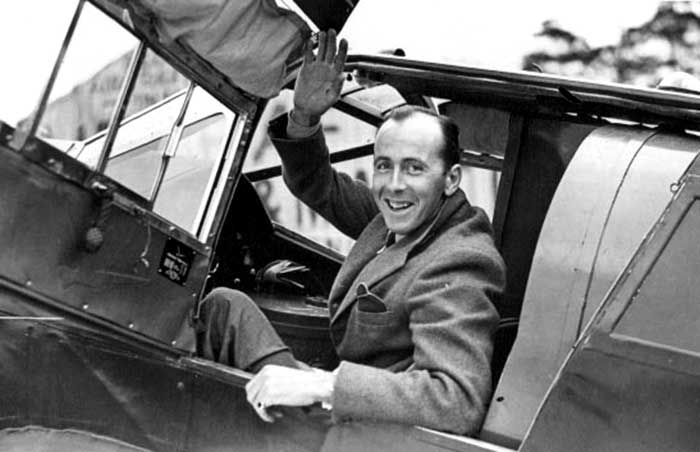
Ben Dannecker collection

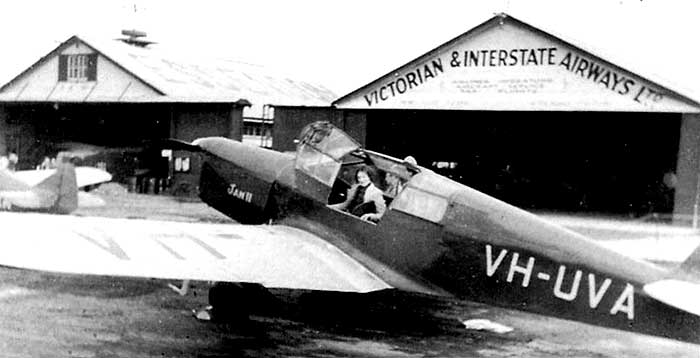

Alice
Springs after repainted white.
Civil Aviation Historical Society
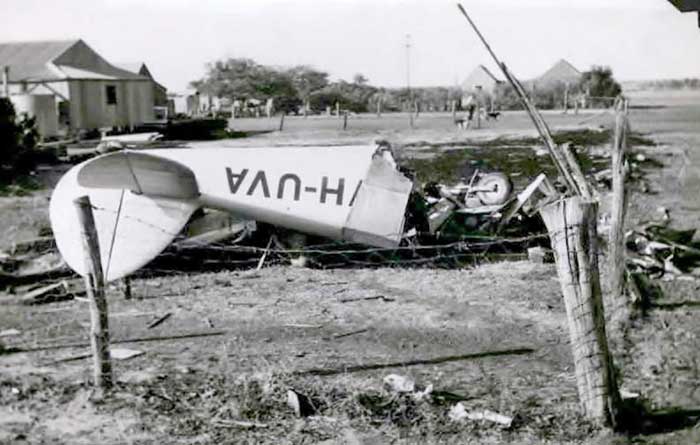
| 8.36 | Built at Luton by Percival Aircraft Ltd. K.1 Vega Gull, 205hp Gipsy Six engine Gull production had just been transferred from Gravesend Airport to Luton Airport |
| 11.9.36 | Australian registration application: J. W. F. Collins, Beaudesert Qld |
| 11.9.36 | Civil Aviation Board allocated registration
VH-UVG to Percival K Vega Gull K.36 to Qantas, conditional upon the aircraft being
shipped out and not delivered by air. (CAB was concerned by legalities of delivery flights under Australian registration and at that time preferred deliveries to be registered in the country of manufacture. Howeber this policy was to be varied many times over the years ahead) |
| 18.9.36 | British CofA application: Percival Aircraft Ltd, Luton |
| 10.36 | First flight |
| 2.10.36 | British CofA issued VH-UVG: Qantas Empire Airways c/- W. Arthur Baird. Collins purchased the Vega Gull through agents QEA at Archerfield Aerodrome, Brisbane |
| Shipped to Australia | |
| 25.11.36 | Testflown Archerfield after assembly by QEA, flown by QEA pilot W. A. Baird |
| 26.11.36 | CAB give permission for VH-UVG to be flown. CofA issue will be delayed awaiting Henry decision |
| 16.12.36 | Flown by Collins in the South Australian Centenary Air Race from Brisbane to Adelaide, race #49. Arrived Parafield 18.12.36. Day 1 Archerfield-Coffs Harbour-Mascot Day 2 Cootamundra-Essendon Day 3 Nhill- Parafield. John Collins won the speed prize £250, flying time 9 hrs 24 mins |
| 29.12.36 | Registered VH-UVG John W. F. Collins, Beaudesert Qld Type quoted as K.1 Vega Gull, 205hp Gipsy Six |
| 29.12.36 | Australian CofA issued |
| 17.11.39 | Letter to Secretary, Department of Air from
Director General Civil Aviation, responding to a request for a
condition report for a list of civil aircraft considered suitable for
impressment for RAAF: "VH-UVG: report by DCA Aircraft Inspector T.L.Amos: aircraft located at Archerfield, fitted with engine no. 4028 with TT 437 hrs. Estimated available in 4 days at maintenance cost £20" |
| 12.39 | Impressed by Australian Government for Royal Australian Air Force for communication duties |
| 5.1.40 | RAAF file memo: "A32-1, ex VH-UVG with CofA. No. 576, received ex J.W.F.Collins, Beaudesert, Qld on this date" |
| 5.1.40 | Taken on RAAF charge as A32-1. Impressed by
RAAF from J. W. F. Collins. Issued to Communications Flight, Laverton. (CF was later renamed No.1CF) |
| 8.1.40 | Struck-off Civil Register |
| 14.10.40 | A32-1 made a forced landing in a farm field 8 miles south of Bairnsdale Vic due engine failure. The aircraft struck a fence, badly damaging the undercarriage and fuselage. Pilot Wg Cdr L.R.S. Freestone and two RAAF passengers were not hurt. |
| 24.11.40 | Issued Ansett Airways, Essendon for repair |
| 7.2.41 | Received 1AD Laverton ex Ansetts |
| 8.2.41 | Issued to No.1 Communications Flight, Laverton ex 1AD |
| 17.6.42 | Departed Essendon for Bairnsdale |
| 7.10.42 | Damaged in forced landing Townsville Qld area, port wheel completely u/s, port wing damaged |
| 9.10.42 | Received No.12 Repair & Salvage Unit, RAAF Garbutt, Townsville |
| 27.10.42 | Allotted Aircrafts Pty Ltd, Archerfield ex 12RSU for repair |
| 28.10.42 | Being crated at 12RSU for shipment |
| 30.10.42 | Delivered to 35 Squadron ex 12RSU for despatch to Archerfield |
| 22.6.43 | Received 1AD. Status Card says "ex Ansetts" assumed error for APL |
| 8.11.43 | Issued 1CF ex 1AD. (No.1 Communications Flight was renamed No.1 Communications Unit) |
| 9.9.44 | Received 82 (Heavy Bomber) Wing Headquarters, Ballarat on loan ex 1CU |
| 16.10.44 | Departed for 1CU ex 82 Wing HQ |
| 24.2.45 | A32-1 noted at Essendon |
| 3.4.45 | Damaged in ground-loop at Mildura Vic, extensive damage to airframe. |
| 30.4.45 | Issued to 1CRD ex 1CU. Request approval to convert to components |
| 12.6.45 | Conversion not approved. Survey report recommends that it should be offered for civil disposal through the Commonwealth Disposals Commission. |
| 12.11.45 | Percival Vega Gull A32-1 included with
aircraft and engines available for purchase in the 3rd Commonwealth
Disposals Commission listing, tenders closing on 21.12.45. - Held at No.1 Central Recovery Depot, RAAF Werribee Vic. - It is fitted with Gipsy VI Series II engine and variable pitch propeller. - This machine was involved in an accident and will be sold in its present condition. The aircraft will require extensive repairs. |
| 18.1.46 | Sold through CDC to F. H. Edwards, 52 Lyndhurst Street, Richmond, Melbourne. |
| 18.1.46 | RAAF Record Card: "Items have been issued and collected ex 1CRD" |
| 12.2.46 | Registered VH-UVG Frederick H. Edwards t/a Edwards Aero Service, Essendon |
| 11.4.47 | CofA issued after repair at Essendon |
| 20.4.47 | Damaged on landing Essendon, pilot A. O.
Kiellerup with 3 passengers. Wing dropped and struck ground, aircraft
swung around and undercarriage was torn off. Major damage. The damaged aircraft was moved to their hangar by Schutt Aircraft Sales & Service staff. |
| 20.4.47 | A witness was Harvey Else was a passenger in Jack Willis' CA-6 Wackett Trainer VH-AIG. He recalls: "We taxied out to the holding position and commenced a pre-takeoff check. I was seated in the rear cockpit. A Percival Gull was approaching to land towards the East, from our right. Suddenly there was a thump, and the aircraft undercarriage collapsed as the left wing hit the ground and the Gull skidded past us and swung around churning up a cloud of dust. The aircraft came to rest about 80 yards away, the door opened, and four people scrambled out and ran from the machine. Almost immediately several DCA vehicles appeared on the scene followed by the fire tender." |
| 14.12.47 | visited airshow at Fishermans Bend, same lightning strike scheme |
| c48 | photo at Mascot parked outside Marshall Airways hangar, lightning strike paint scheme |
| 23.8.48 | Crashed on takeoff Farina SA when the main wheels ran into mud. Owner/pilot Edwards and a passenger were unhurt |
| 23.8.48 | Change of ownership (date back-dated): H. P.
& J. P. Davis. Hamilton Downs Pastoral Co, “Hamilton Downs”, via
Alice Springs NT Purchased by Pat Davis in dismantled damaged condition after the Farina accident |
| 7.12.48 | Struck off Register |
| 24.1.49 | Letter to DCA from H.P. Davis: UVG is under rebuild at Parafield. He was expecting it to be airworthy by the end of January but after inspecting it today he now doubts it will be completed before April 1949. Requests CofA extension for his airworthy Gull VH-ACM |
| 7.2.49 | Restored to Register VH-UVG H. P. & J. P. Davis. Hamilton Downs Pastoral Co |
| 5.49 | DCA memeo: UVG rebuild continues at Parafield |
| 7.12.49 | CofA renewed at Parafield |
| 6.12.50 | Annual CofA expired, owner was overseas |
| 3.7.51 | noted at Parafield in a hangar, cream with red trim |
| 6.8.51 | Struck-off Register in the 1951 DCA Census of unairworthy aircraft |
| 26.11.52 | Registration application: H. P. Davis, Adelaide SA Application submitted on his behalf by Harry W. Price of Aviation Services (SA) Ltd, Parafield |
| 2.2.53 | CofA renewed at Parafield |
| 2.2.53 | Restored to Register H. P. Davis, Adelaide SA |
| 5.2.53 | Change of ownership: Albert E. Picken, Adelaide SA |
| 31.10.53 | Change of ownership: G. B. “Jack” Black, Minnipa SA. Jack Black was widely known as "The Flying Storekeeper", previously owning an Auster. |
| 26.11.53 | Broke up in flight Pondooma, near Cowell SA. Owner Jack Black was killed Black was on a flight from Adelaide to Minnipa without passengers. Control of the aircraft was apparently lost while flying in cloud resulting in structural failure. A newspaper report quoted a witness: "We looked up in time to see the plane nose diving out of the clouds. Suddenly pieces of the plane broke away. Some fell two miles from where the plane crashed and a wing was found some distance from the wreck." |
| 26.11.53 | Struck-off Register |
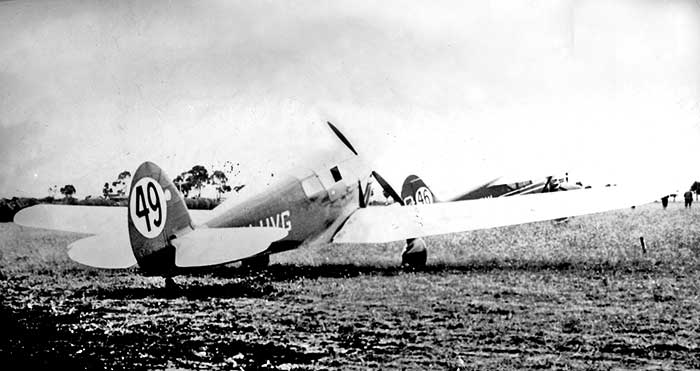
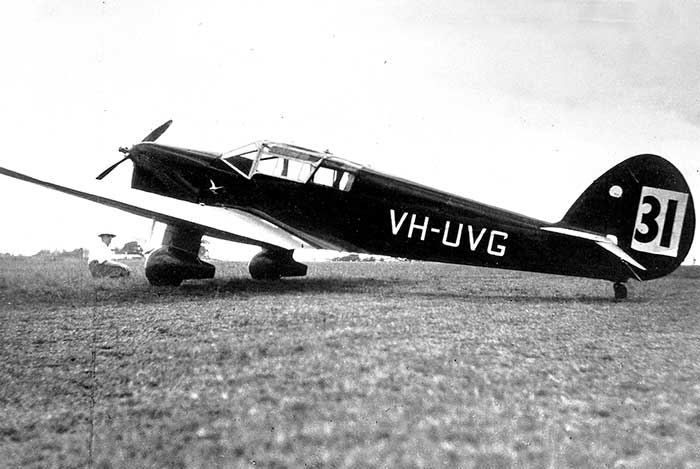
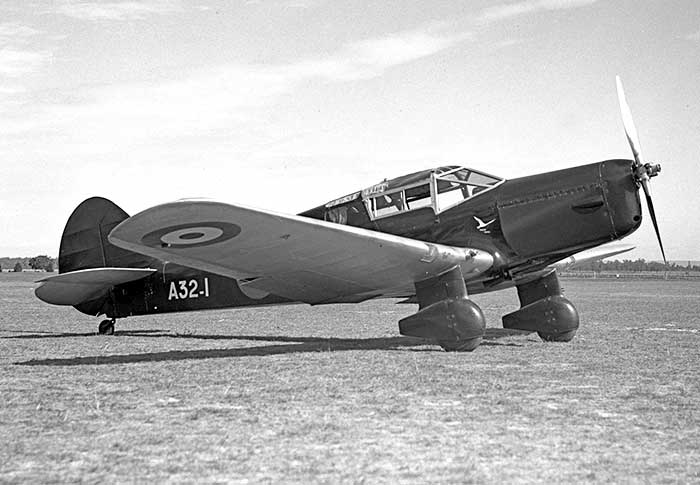
including the Gull motif under the windscreen. John Hopton Collection

This photo of A32-1 at an unknown location in 1940 is courtesy of Peter Jordan, who found it in his father
Kevin's photo album. Kevin, standing on the right, worked at the time for "Bolton's Talkies" travelling
movie show, going from town to town across northen NSW and southern Queensand
Kevin's photo album. Kevin, standing on the right, worked at the time for "Bolton's Talkies" travelling
movie show, going from town to town across northen NSW and southern Queensand
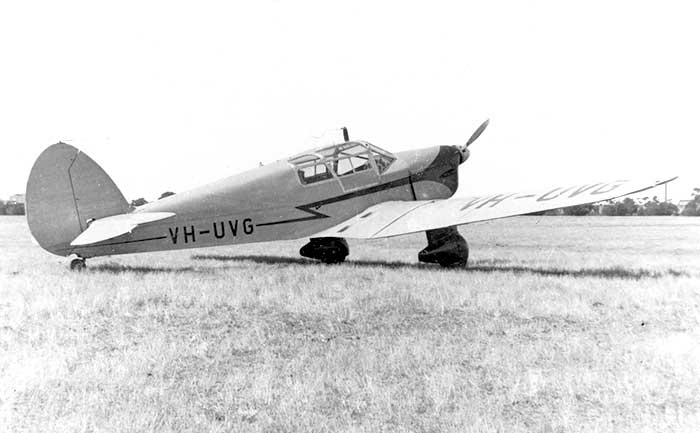
| .37 | Built at Luton by Percival Aircraft Ltd as a production Vega Gull Mk.1 Engine 200hp Gipsy Six 1 Gull production had been transferred from Gravesend Airport to Luton Airport late 1936. |
| 21.4.37 | Civil Aviation Board allocate registration VH-UZH to Percival K Vega Gull K.58 for Goldfields Airways |
| 30.4.37 | Application for British CofA |
| 27.5.37 | British CofA issued: VH-UZH Goldfields Airways Ltd, Kalgoorlie, Western Australia |
| Founder of Goldfields Airways was WW1 pilot George W. Lewis. He was owner and chief pilot until the company ceased operations in 1962. As well as general charter flying, Lewis held the Flying Doctor Service contract for the Kalgoorlie radio base and in 1937 used a DH.83 Fox Moth. He continued to provide the aerial medical service for the Goldfields until the RFDS based its own Cessna 180 at Kalgoorlie in 1958 | |
| Shipped to Fremantle WA in a wooden crate, assembled at Maylands aerodrome, Perth | |
| 6.7.37 | Australian Registration Application: George Wyndham Lewis/ Goldfields Airways Ltd, Kalgoorlie WA |
| 7.7.37 |
First flight after assembly at Maylands, flown
by local pilot Harry "Cannonball" Baker. George Lewis requested Baker make the first test flight because of his experience on monoplanes. Lewis was in the right hand seat. The aircraft was fitted with dual controls |
| 7.7.37 | Later in the day, George Lewis took Horrie Miller (founder of Perth airline MMA) and Captain James Woods (MMA chief pilot) for a local flight at Maylands |
| CAB approved UZH to commence operations, pending issue of CofR and CofA by CAB Head Office | |
| 9.7.37 | Delivered Maylands to Kalgoorlie by Lewis. Flying time 2 hrs 30 mins, compared with up to 6 hours in his DH.60 Moth VH-UPD and his Fox Moths |
| 11.7.37 | Vega Gull's first revenue flight was to take Dr. Alan Webster to help two miners gassed in a mine shaft near Widgiemooltha, 50 miles south of Kalgoorlie. Lewis landed UZH on a dry lake bed |
| 19.11.37 | Registered VH-UZH Goldfields Airways Ltd, Kalgoorlie WA Type quoted as D.1 Vega Gull, 200hp Gipsy Six 1 Reason for the delayed formal certification by CAB unknown |
| 19.11.37 | Australian CofA issued |
| 38 | Lewis flew a number of charters from Kalgoorlie to the northern WA Pilbara region, carrying geologists. |
| 7.38 | Lewis departed Kalgoorlie at dawn in UZH after
working all night to complete an engine top overhaul, to search for his
missing Fox Moth VH-UTY with pilot Clive Foreman. The Fox had been on a medical flight to Warburton Range to evacuate a missionary with appendicitis at the aboriginal reserve. Lewis located UTY safely on the ground at Laverton WA, then continued to Warburton Range in UZH where he landed in a clearing because there was no landing ground |
| The following flights are extracted from non-consecutive pages of George Lewis' pilot logbook. VH-UZH could have also been flown by other Goldfields Airways pilots during this period: | |
| 19.1.39 | Log: Kalgoorlie-Wiluna, returned to Kalgoorlie next day |
| 22.1.39 | Log: Kalgoorlie-Perth, returned to Kalgoorlie next day |
| 28.1.39 | Log: Kalgoorlie-Ravensthorpe and return via Esperance |
| 1.2.39 | Log: Kalgoorlie-Wiluna-Marble Bar |
| 3.2.39 | Log: Marble Bar-Port Hedland-Wiluna |
| 4.2.39 | Log: Wiluna-Nannine-Agnew-Laverton |
| 5.2.39 | Log: Laverton-Kalgoorlie |
| 12.2.39 | Log: Kalgoorlie-Esperance-Kalgoorlie, patient with appendicitis |
| 14.2.39 | Log: local flight Kalgoorlie |
| 27.2.39 | Log: Laverton-Leonora-Kalgoorlie |
| 28.2.39 | Log: Kalgoorlie-Wiluna |
| 2.3.39 | Log: Wiluna-Kalgoorlie |
| 3.3.39 | Log: Kalgoorlie-Wiluna-Kalgoorlie |
| 16.2.39 | Log: Kalgoorlie-Wiluna |
| 17.3.39 | Log: Wiluna-Kalgoorlie |
| 19.3.39 | Log: Kalgoorlie-Esperance |
| 20.3.39 | Log: Esperance-Kalgoorlie |
| 23.3.39 | Log: Kalgoorlie-Cue |
| 24.3.39 | Log: Cue-Kalgoorlie |
| 27.3.39 | Log: Kalgoorlie-Perth |
| 28.3.39 | Log: Perth-Kalgoorlie |
| 30.3.39 | Log: Kalgoorlie-Southern Cross-Kalgoorlie |
| 3.4.39 | Log: Kalgoorlie-Wiluna-Marble Bar |
| 5.4.39 | Log: Marble Bar-Wiluna-Agnew-Laverton |
| 6.4.39 | Log: Laverton-Kalgoorlie |
| 8.4.39 | Log: Kalgoorlie-Wiluna |
| 9.4.39 | Log: Wiluna-Perth: |
| 11.4.39 | Log: Perth-Kalgoorlie, 2hrs 15 mins |
| 11.39 | Whooping cough outbreak at Kalgoorlie. UZH flew a series of flights carrying patients to 10,000 feet to alleviate the symptoms |
| 2.40 | UZH flew another series of flights carrying whooping cough patients to 10,000 feet to alleviate the symptoms |
| 5.40 | Lewis flew a long distance charter Kalgoorlie-Wiluna-Marble
Bar-Broome-Wyndham-Darwin-Pine Creek. Returned to Kalgoorlie. |
| 8.40 | Lewis complains bitterly to DCA regarding the poor quality of an engine overhaul on UZH carried out by Airlines (WA) Ltd at Maylands. He rejects the DCA response and has the matter raised in WA Parliament |
| 1.41 | Medical flight Kalgoorlie-Esperance carrying doctor and returning with patient |
| 41 | Lewis flew UZH in the North West of WA on military contracts, searching for strategic minerals |
| 7.41 | Medical flight to collect an injured Army worker from the construction team on the East-West road, Lewis landing on a landing strip prepared by the workers. |
| 10.41 | Tailwheel of UZH replaced by a complete unit removed from Cierva Autogiro VH-UUQ which had been retired at Maylands for some years |
| 2.2.42 | Lewis flew UZH from Kalgoorlie to Derby WA to help in evacuation of personnel from the iron ore mining site at Yampi Sound near Derby due to the threat of Japanese invasion. Flew a shuttle from Derby to Broome carrying workers. Then returned to Kalgoorlie carrying 3 BHP mining officials to a BHP mine at Kalgoorlie. |
| 3.42 | UZH painted in camouflage at Kalgoorlie as requirement of a DCA contract for Lewis to fly the Vega Gull to Darwin to operate on instructions from the military authorities. |
| 17.3.42 | Lewis departed for Darwin: Kalgoorlie-Wiluna-Marble Bar-Fitzroy Crossing. Next day continued to Ord River-Katherine where he waited for further instructions. |
| 20.3.42 | Katherine to Batchelor, where based with a Flying Doctor Service Fox Moth from Port Hedland. Lewis carried out all maintenance on both aircraft. UZH flew patrols from Batchelor to the WA coast at Wallal, reporting radio transmissions from inbound Japanese aircraft, plus carrying military personnel, including collecting rescued downed RAAF pilots |
| 4.42 | Returned to Kalgoorlie |
| 2.4.42 | The RAAF request for VH-UZH at Darwin is
mentioned in a memo to Dept of Air from Western Area from Wg. Cdr.
Norman Brearley dated 2.4.42: 1. Mr. Lewis, Civil Aviation, left Kalgoorlie 17/3, in a Vega Gull for operations with the V.A.O.C. in Darwin Area. The aircraft was on charter for a period of approximately three weeks. Mr. Lewis, however, has returned south on his own accord, for reasons unknown to this Directorate. 2. The Officer in charge V.A.O.C. Darwin Area, urgently needs replacement. 3. Mr. Edwards, Civil Aviation, an experienced Pilot, who knows the country well, is available and willing to undertake the work in place of Mr. Lewis. 4. As no Civil Aircraft is available, it is requested that a Vega Gull, Fox Moth, or a similar type of Aircraft, be allotted to V.A.O.C. Darwin Area, for this purpose." |
| 24.4.42 | Director General Civil Aviation wrote to
Secretary, Dept of Air in response to proposal to use a civil aircraft for
inspection of landing grounds in Western Australia for U.S. Authorities: "With regard to your enquiry regarding Mr. G.W.Lewis's Percival Vega Gull aircraft, this machine is used on charter flights at a locality not normally served by other aircraft, and in addition is operated on a flying doctor service based at Kalgoorlie. In the circumstances, it is considered undesirable that this aircraft should be impressed." VH-UZH was excluded from impressment by RAAF due to its essential work at Kalgoorlie. A DCA report states that Lewis flew UZH extensively on medical work also surveys for strategic minerals. which continued into 1944 |
| 10.43 | Lewis flew UZH Kalgoorlie to Warburton Range mission, landing on a cleared airstrip and refuelling from a supply of
aviation fuel Goldfields Airways kept at the mission. Returned to
Kalgoorlie direct that day |
| 43 |
Geological exploration flights in Pilbara
district, searching for deposits of tantalite, urgently need by the US
for radar and avionics. Also flights to Campion, 150 miles west of
Kalgoorlie in support of a plant extracting potash |
| 2.44 | UZH commenced a complete engine and airframe overhaul by Lewis, who incorporated numerous modifications, improved fuel cocks, oil lines replaced by metal lines, better cooling for the engine. Fabric surfaces of the fuselage centre-section were skinned with plywood |
| 44 | UZH flew several mining charters to Reedys mine near Cue. A long trip was Kalgoorlie-Wiluna-Nullagine-Marble Bar-Wodgina-Port Hedland-Wodgina-Reedys-Kalgoorlie. |
| 1.9.44 | Log: Norseman-Wiluna at night to collect a patient with eye injury. To Perth next day, then back to Norseman to collect charter passengers left there. |
| 1.46 | UZH had an engine change to a 205hp Gipsy Six II |
| 8.1.47 | UZH departed Geraldton at 7am to accompany ex RAAF Avro Anson W2121 on ferry flight to Kalgoorlie after purchase by Lewis from Commonwealth Disposals Commission. |
| 8.1.47 | UZH made a forced landing in farmers field at East Buntine WA, Anson landed alongside. Neither aircraft damaged. |
| 9.1.47 | UZH & W2121 departed East Buntine and arrived Kalgoorlie that day. (Anson W2121 became VH-BEL with Goldfields Airways, later joined by Anson VH-BXC. George Lewis was to later make the last flight of any Australian wooden-wing Anson following the DCA grounding order on the type effective 30.5.62. To allow Lewis to complete a photographic survey near Kalgoorlie, based on his proven operating standards, DCA extended VH-BEL's CofA to 4.9.62) |
| 5.8.47 | UZH testflown Kalgoorlie by Lewis after CofA renewal |
| 29.2.48 | Damaged when overran rough strip at Morleys Find and struck a dead tree. Lewis was flying in supplies to flood-bound people stranded nearby. Wing spar and leading edge of the starboard wing damaged. Lewis made temporary repairs on site using wood from dynamite cases and furniture glue, then ferried UZH to Kalgoorlie at reduced speed |
| 3.48 | Repairs commenced at Kalgoorlie, Lewis replacing more fabric surfaces with plywood |
| 5.51 | Goldfields Airways contract with Flying Doctor Service Eastern Goldfields Section was renewed, to provide aircraft for medical flights as required, using Ansons and the Vega Gull |
| 15.10.51 | UZH flown by George Lewis in the aerial search for the missing Airlines (WA) Ltd DH.104 Dove VH-AQO inbound to Kalgoorlie from Perth. The wreck was located 15 miles west of Kalgoorlie |
| 10.53 | UZH advertised for sale by Goldfields Airways “Reason for selling – decline in gold mining”, Not sold. Continued on charter and carring doctors on clinic runs from Kalgoorlie. |
| 5.5.60 | Log: George Lewis' last flight in UZH |
| 20.5.60 | Change of ownership: Peter T. MacNeil, Perth WA |
| 20.5.60 | Tipped on nose taxying at Perth Airport for Maylands aerodrome, damage to cowling and propeller |
| 26.9.60 | Change of ownership: Reginald C. Currell, Perth WA. Based at Maylands Aerodrome, Perth |
| 26.2.61 | Crashed during forced landing near Yerecoin
WA While on a flight from Maylands to Miling WA, pilot Currell and 3 passengers. No injuries DCA accident report: "The pilot lost control during landing and port undercarriage collapsed" |
| 11.4.61 | Struck-off Register |
| The damage to the wooden airframe made it an insurance write-off. Wreck stored in a garage at Yerecoin for some months, then moved by road to Maylands. The engine was stored at Currell’s house in Perth until sold circa 1963 to Bob Couper Co, Cunderdin WA | |
| 23.2.63 | Damaged airframe of VH-UZH noted stored dismantled at Maylands, in John Forrest’s hangar: tail section on top of office inside hangar, wings against hangar walls, plus parts |
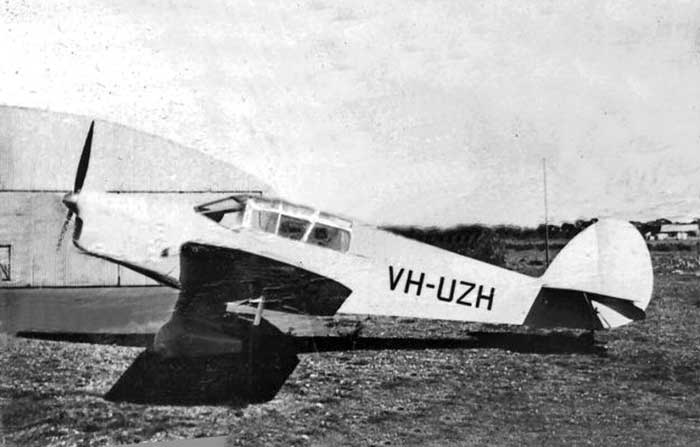
| .37 | Built at Luton by Percival Aircraft Ltd. DH Gipsy Six Series 2, constant-speed propeller Gull production had been transferred from Gravesend Airport to Luton Airport late 1936. |
| 16.10.37 | British CofA application Percival Aircraft Ltd, Luton |
| 4.1.38 | British CofA issued: The Shell Co of Australia Ltd, Melbourne |
| 17.2.38 | Australian registration application: The Shell Co of Australia Ltd c/- E. J. Jones |
| 18.2.38 | Arrived Melbourne as cargo on board the ship Moreton Bay |
| 18.2.38 | Registered VH-ABS: The Shell Co of Australia Ltd, Melboune Vic |
| 2.38 | Assembled at Essendon by Ansett Airways |
| 25.2.38 | CAB Inspection report at Essendon after assembly. Red, yellow & black colour scheme. |
| 25.2.38 | Testflown Essendon, pilot Frank Wright |
| 2.3.38 | Local flight Essendon, pilot Frank Wright, Shell Oil Co, passenger photographer John Harrison |
| 4.3.38 | Local flight Essendon, pilot H. C. Owen, Shell Oil Co, passenger photographer John Harrison |
| 38 | Maintained by Ansett Airways at Essendon, aircraft was away from Melbourne for long periods |
| 28.2.39 | Destroyed in Ansett Airways hangar fire at Essendon Aerodrome, Melbourne |
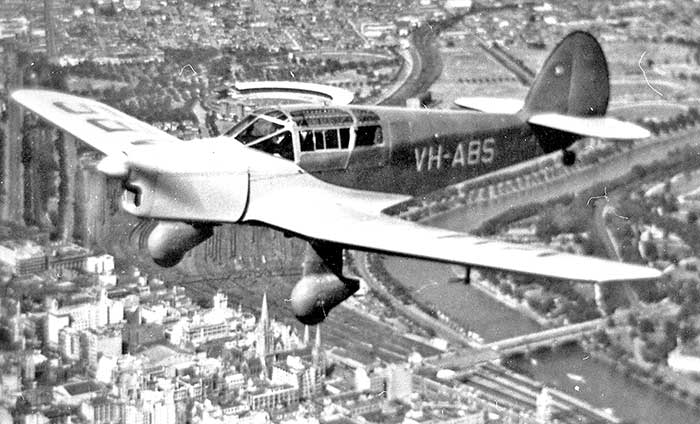
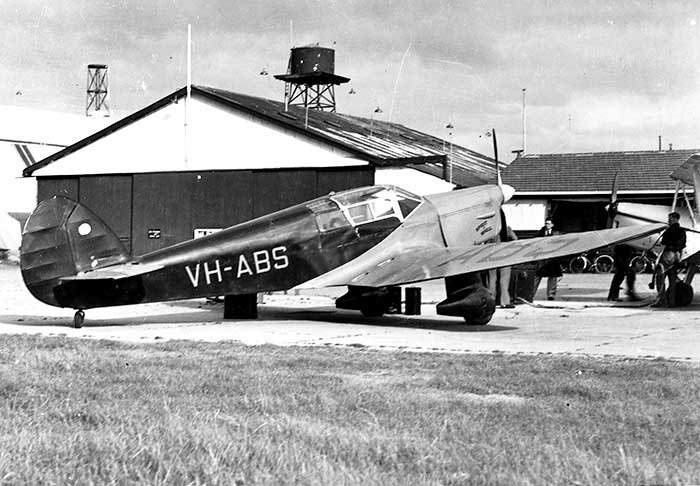
| 17.3.38 | British application for CofA: Percival Aircraft Ltd, Luton |
| 8.4.38 | Construction completed at Luton by Percival Aircraft Ltd. Late production Vega Gull with rounded windscreen which became standard on the following Proctor production |
| 13.4.38 | British CofA issued as VH-ACA: Major The Hon Richard G. Casey, Berwick Victoria, Australia |
| Richard Gardner Casey was born 29 August 1890 in Brisbane, graduated in engineering at Cambridge University in Britain.
He worked as a geologist and mining consultant in Queensland, New
Guinea and USA before joining the Australian Imperial Force at outbreak
of WWI, serving at Gallipoli and the Western Front, achieving the rank
Major and awarded Military Cross and DSO. In 1924 he was appointed Australian Liaison Officer in London. Returned to Victoria in 1931 and entered Federal politics, becoming Treasurer, later Minister for Supply and Development. In January 1940 Prime Minister R. G. Menzies appointed Casey as Minister to the United States, based Washington DC, a move widely seen as using the war situation to distance his main political rival. In March 1942 Winston Churchill appointed Casey as UK Minister for State in the Middle East, based Cairo. In January 1944 Churchill appointed him Governor of Bengal, India. Casey returned to Australia in 1946 and was re-elected to Federal Parliament under Menzies, and served again as Minister for Supply and Development, then Minister for External Affairs. In 1960 Casey was made a Life Peer of the British House of Lords. In September 1965 he was appointed Australian Governor-General until April 1969 when he retired to his property near Berwick, Victoria with title Lord Casey of Berwick. His last two aircraft, Messenger VH-AVQ and Cessna 180 VH-RGC were hangared at Berwick airfield. | |
| 2.4.38 The Argus newspaper, Melbourne: “Like the wartime aces of the German air force, the Federal Treasurer, Mr. Casey, intends that his new aeroplane should be finished in a distinctive colour. He has asked the manufacturers to lacquer his new Gull primrose yellow. On the wings and fuselage the machine will bear the registration letters VH-ACA. Appropriately enough the terminal letters will be first two both in the owner’s name and in his official place of business – Canberra. Mr. Casey expects to receive it before the end of the year.” | |
| Shipped to Sydney | |
| 7.38 | Assembled at Mascot Aerodorme, Sydney by De Havilland Aircraft Pty Ltd under supervision of Percival agent Captain P. G. Taylor |
| 8.7.38 | First test flight at Mascot sfter assembly |
| 11.7.38 | Testflown at Mascot by P. G. Taylor, Australian agent for Percival Aircraft |
| 12.7.38 | Australian Registration application: Rt. Hon. Richard G. Casey, Parliament House, Canberra ACT. Application signed in Casey's behalf by by P. G. Taylor |
| 21.7.38 | Registered VH-ACA |
| 21.7.38 | Australian CofA issued |
| 7.38 | Newspaper reports that Casey will fly his new Gull to Alice Springs shortly |
| Name Corio Gull painted on nose cowling. Casey regularly flew the Vega Gull between his airfield at Berwick and Canberra | |
| 13.11.39 | Tailwheel damaged while taxying Mascot due rough surface near Aero Club. Pilot W.A.J. Baker |
| 17.11.39 | Letter to Secretary, Department of Air from Director
General Civil Aviation, responding to a request for a condition report
for a list of civil aircraft considered suitable for impressment for
RAAF: "VH-ACA: owned by The Hon. R.G.Casey: aircraft in very good condition - report by Superintendent A.E.Shorland, Essendon, total airframe time 220 hrs." |
| 11.39 | Impressed by Australian Government for use by RAAF for communications duties. Impressment No.12517. Casey was later reimbursed £2,800. |
| 15.1.40 | RAAF file memo: "A32-2, ex VH-ACA with CofA no. 666, received ex the Rt.Hon R.G.Casey, M.P. on this date" |
| 15.1.40 | Taken on RAAF charge as A32-2. Allotted Communications Flight, Laverton |
| 15.1.40 | Struck-off Civil Register |
| 7.2.40 | Forced landing. Exhaust manifold broke in flight and the resulting flame caused a small portion of the lower fuselage to be burnt. Pilot was Flying Officer F. Neale, Communications Flight |
| Communications Flight was renamed No.1 CF effective 2.12.40 based at Laverton. Unit was renamed No.1 Communications Unit 6.1.43 | |
| 9.4.42 | Issued to Ansett Airways, Essendon ex 1CF for maintenance |
| 22.6.42 | Received 1CF ex Ansett |
| 15.3.43 | Issued to Ansett Airways, Essendon ex 1CU for maintenance |
| 19.7.43 | Received 1AD ex Ansett |
| 30.7.43 | Received 1CU ex 1AD |
| 23.8.43 |
Propeller damaged when aircraft tipped on its nose due to a wheel dropping into a pothole after landing. Pilot Sqn Ldr E.H. Loneragan, Member for Training on the Air Board. Location not stated in accident report, probably RAAF Narromine |
| 13.7.45 | Forced landing Rutland Square, 3 miles north west of Sydenham Vic. Recommended for field repair |
| 26.7.45 | Received Point Cook ex 1CU, pending disposal by Commonwealth Disposals Commission |
| 5.8.45 | Transferred to Central Flying School, Point Cook for storage |
| 9.45 | Ken MacDonald, then an instructor at CFS Point Cook
later wrote: "We carried on as usual until the sudden end of the war with the dropping of the atomic bombs on Japan. Almost overnight orders came through from Government that all instruction was to be terminated immediately and flying restricted to essential flight only and fuel consumption had to be reduced to an absolute minimum. So there we were at Point Cook in a kind of limbo with virtually nothing to do. The mechanics tried to keep busy, they carried out all the inspections which generated a few test flights, but in due course they found little to do, so they dragged out any aeroplane that had been sitting unused in the back of the hangar down by the pier. One was the Vega Gull originally owned by Lord Casey, and appropriated by the Government early in the war. Anyway out it came and one day they pronounced it airworthy so my mate Bob Ogden and I took it up for a bit of fun which turned out more than expected, with the brakes being connected the wrong way round, left brake to right rudder and vice versa." He added that also stored in that hangar was the sole RAAF Hurricane V7476, which was made airworthy again at that time and MacDonald test flew it at Point Cook |
| 8.11.45 | RAAF HQ memo: approval given for issue of Vega Gull A32-2 to Loneragans in exchange for their Beech 17 VH-UXP which was impressed |
| 8.11.45 | RAAF Airframe Status Card: "Not now available for disposal. To be made airworthy for issue to Jas Loneragan (Mudgee) in exchange for Beechcraft A39-3. Approval granted for issue to Jas Loneragan in exchange for A39-3 which was previously made available on free loan to RAAF." |
| 12.12.45 | Letter to DCA from Jas Loneragan (Mudgee) Co Pty Ltd, Mudgee: they have purchased from the RAAF Percival Gull A32-2 previously with Mr. Casey. Sqn Ldr Loneragan had visited DCA Melbourne some weeks ago regarding this aircraft presently situated at Point Cook. DCA had suggested that they engage Victorian and Interstate Airways at Essendon to carry out the civil inspection, but VIA's Mr. Hart is not available |
| 9.5.46 | RAAF Airframe Status Card: A32-2 received Point Cook ex CFS |
| 5.6.46 | RAAF Airframe Status Card: aircraft issued to Mr. Loneragan, Mudgee NSW on free issue |
| 12.6.46 | Civil Registration application: U Drive Pty Ltd, Sydney NSW U-Drive was a car rental service operated by Eric E. McIllree, who was a partner with Jas Loneragan (Mudgee) Co Pty Ltd in establishing a new business Aircraft Disposals Co, Mudgee. 40 RAAF disposals Avro Ansons and other types were purchased for civil conversion and commercial resale |
| 24.12.46 | Restored to Register as VH-ACA U Drive Pty Ltd, Sydney NSW |
| 24.12.46 | CofA issued at Essendon, aircraft to be based Mudgee |
| 7.10.47 | Change of ownership: Jas Loneragan (Mudgee) Co Pty Ltd, Mudgee NSW |
| 26.11.48 | DCA letter advising that a change of registration is required for registrations that conflict with new International radio callsigns and Q Code. VH-ACA will no longer be available and suggests the registration be changed to VH-BQA to minimalise the repainting required. The actual repainting may be delayed until the next annual CofA inspection |
| 18.4.49 | Wing damaged during forced landing near Bathurst NSW. Still painted as VH-ACA. Pilot Peter J. Loneragan and three passengers were unhurt, on a fight Mudgee to Bathurst for a car race at Bathurst. Forced landing in a small paddock at Sally's Flat, 36 miles north of Bathurs, due engine problem 18 inches of one wing torn away when struck fence |
| 2.6.49 | Re-registered VH-BQA |
| Stored damaged after the 18.4.49 accident | |
| 6.8.51 | Struck-off Register in the 1951 DCA Census of unairworthy aircraft |
| 7.1.52 | Restored to Register VH-BQA Jas Loneragan (Mudgee) Co Pty Ltd, Mudgee NSW |
| 7.1.52 | CofA renewed |
| 1.7.54 | Change of ownership: Reginald Geary, Sydney |
| 5.7.54 |
Reg Geary applied to DCA for a new Charter Licence in the name
Sydney Air Taxis Co, using Vega Gull VH-BQA. His previous charter licences since 1952 with Genairco VH-UUI and later Proctor VH-BQQ had lapsed |
| 22.9.54 | Charter Licence & Airwork Licence issued to Geary Geary had a contract to fly fresh fish to Bathurst from Cams Fishery at Pyrmont, Sydney using the Proctor and Gull. The Vega Gull had a stainless steel container constructed to fit in the back of the cabin, replacing the rear seats. The return load was also fish, this time river fish such as barramundi. Often flown by ex RNZAF wartime fighter pilot Trevor Thiele, who also flew for Marshall Airways |
| 9.4.56 | Complaints to DCA re Vega Gull BQA operating into the old Woy Woy airstrip which is now closed |
| 30.6.56 | Geary’s charter licence expired. DCA refuse to renew for 4 months due to his poor operations at Bourke earlier that year and dishonoured cheques for charts he purchased at Dubbo Aeradio station |
| 18.9.56 | VH-BQA repossessed from Geary by Rural Finance of Mudgee, Mudgee NSW (a Loneragan company) |
| c59 | Badly damaged in ground-loop. Not listed in DCA annual Accident summaries |
| 30.6.59 | Struck-off Register |
| 1.73 | noted as a wrecked airframe in the open weather on a Loneragan property at Mudgee, alongside the dismantled remains of Loneragan’s Avro Anson VH-BLG. |
| 2.76 | noted same location near Mudgee, totally derelict, small forward section of cockpit, engine mounts and wing centre section with undercarriage legs |
| 70s | Remaining airframe in poor condition acquired by John Hill,
Brisbane Qld. Included engine, cowlings & propeller which were stored
under cover at Mudgee. Hill also had the remains of Gull VH-UTP which he planned to restore in partnership with Don Johnston |
| 86 | Gull VH-UTP's derelict fuselage and wings stored in Don Johnston's
workshop at Beenleigh Qld. Reportedly owned jointly by Don Johnston and
John Hill. In the same workshop are the remains of VH-BQA, described
as "in a pitiful state" Don Johnson wrote in a later letter: “The two aircraft VH-UTP and VH-BQA are only connected by the fact that they were both stored at my property for some time. Great care was taken to keep parts from both aircraft separated. VH-BQA is the subject of another restoration” |
| 80s | BQA remains purchased by Graham Orphan, Brisbane. Stored on a farm. Graham Orphan wrote in 2012: "It became derelict on the Loneragan farm at Mudgee after a ground loop resulted in a damaged wing that was never repaired. It was recovered by John Hill during the 1970s. I bought it from John Hill about a decade later and stored it on our farm in Queensland. I then moved temporarily to NZ in 1990 (and am still in NZ) so this delayed any start on the project and I subsequently got involved in various other aircraft restorations here. I had been approached by a British chap who wanted to swap a Chipmunk for it, but I thought it would be wrong for such a significant aircraft to leave Australia. This was the same reason I had not shipped it to New Zealand to rebuild here. All along, Leigh Giles had been nagging me to sell it to him in order to guarantee it would be restored and would remain in Australia. Having been in NZ for a few years and having not made any progress on the Vega, I felt I was thwarting its chances of restoration so I reluctantly sold it to Leigh, happy in the knowledge that it would at last have a chance of returning to the skies over Australia much sooner than if it remained with me." |
| .98 | Purchased as a restoration project by Leigh Giles, Lara Vic |
| Airworthy restoration commenced. Outer wings acquired | |
| 9.03 | Leigh Giles advertised for Proctor or Gull parts or manuals to
assist in the restoration of Lord Casey's Percival Gull VH-ACA to airworthy |
| 11.05 | Leigh Giles advertises his Percival collection for sale: Vega Gull VH-ACA, Proctor 2 VH-SCC, Proctor 3s VH-AHR. BEG, BXU, KZG |
| 11 | Reported that little restoration had been carried out of the Vega Gull, but some missing components have been acquired |
| 12 | Brothers Gerry and Andrew Smith from Surrey, England, wanted to restore a Percival Gull to fly and possibly repeat one of the type’s many record flights of the 1930s. They visited Australia to inspect Leigh Giles’ VH-BQA project and purchased it. Heritage Export permission was granted. |
| 12 | Purchased by Gerry and Andrew Smith, Surrey, England. Gerry is airfield manager of Popham Airfield, Winchester, Hants |
| 19.10.12 | The packed project parts collection arrived in UK |
| 1.15 | Gerry Smith writes to advise that VH-BQA’s remains are still stored in his home garage, while waiting to acquire suitable premises in which the aircraft will commence airworthy restoration |
| 9.15 | The Vega Gull remains were displayed by Gerry Smith at an air rallye at Sywell, Northants |
| 10.8.21 |
Registered G-HACA Gerald C. Smith, Gosport |
| 8.21 |
Update from owner Gerry Smith in England: "I now have a team of like-minded enthusiasts and we are progressing the restoration. I have registered the project with the UK CAA. It is now located in an industrial unit in Overton, Hampshire. I have been funding this from proceeds of my house sale, but have opened a GoFundMe page to help with the restoration. It is still my intention, if at all possible, to fly her to Australia when complete." |
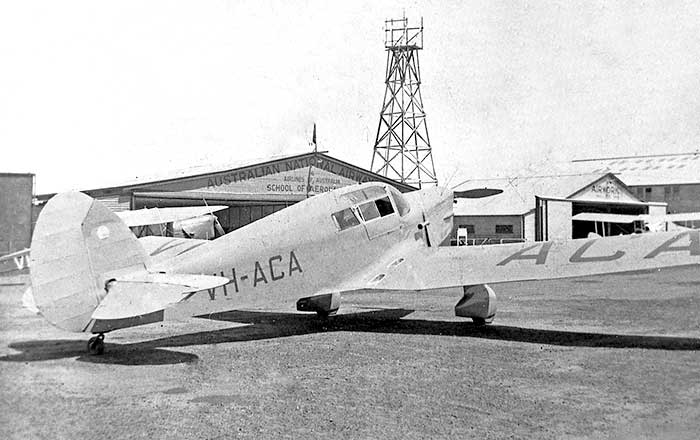
Photo: Neil Follett collection

Photo: Neil Follett collection

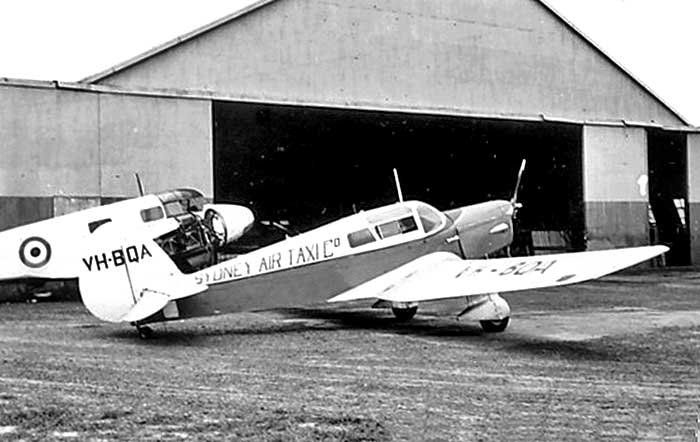
Geoff Goodall collection
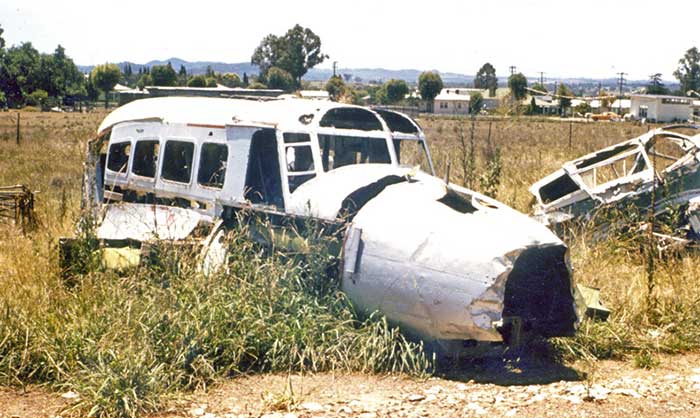
Photo by John S. White
C/n D.46 Percival D.3 Gull 6 VH-ACM, VH-CCM
| .34 | Built at Gravesend by Percival Aircraft Ltd. Model D.3 Gull Six. Gipsy Six engine. |
| 18.6.34 | Registered G-ACUP K. H. Williams, Shoreham, Shoreham for Miss Diana Williams, Cardiff, Wales |
| 5.7.34 | First flight Gravesend |
| 7.7.34 | British CofA issued |
| 14.7.34 | Flew in 1934 Kings Cup Air Races, pilot Flt Lt H. H. Leach, race #29 |
| 7.9.35 | Flew in 1935 Kings Cup Air Races, pilot T. W. Morton, race #12 |
| .37 | Change of ownership: Stanley Kenneth Davies, Cardiff, Wales |
| 2.7.38 | Flew in 1938 Kings Cup Air Races, pilot Flt Lt H. Thomas-Ferrand, race #14 |
| 18.4.39 | Annual CofA renewal |
| .39 | Purchased by E. J. Connellan, Alice Springs NT via aircraft brokers W. S. Shackleton Ltd, London.
Eddie Connellan knew Shackleton from his earlier days as chief designer for Larkin Aircraft Supply Co at Coode Island Aerodrome, Melbourne |
| 15.5.39 | G-ACUP struck-off British Register as sold to Australia |
| 6.39 | Shipped to Sydney as cargo on board Largs Bay |
| 27.6.39 | Letter from Connellan's legal firm to DCA refers to "Percival Gull VI G-ACUP now on the water for E. J. Connellan" |
| 13.7.39 | Docked at Sydney |
| 7.39 | Assembled at Mascot Aerodrome, Sydney by De Havilland Aircraft Pty Ltd. Aircraft is painted as G-ACUP in a light blue scheme |
| 31.7.39 | Registered VH-ACM Edward J. Connellan, Alice Springs NT |
| 31.7.39 | Australian CofA issued at Mascot |
| 7.39 | DCA approve Connellan's reaquest to operate the aircraft wearing the British registration markings G-ACUP for two months, due to difficulty in removing those markings and the aircraft being urgently required at Alice Springs to operate the Alice Springs-Wyndham air mail service |
| 7.39 | When Connellan arrived in Sydney to collect this second Gull for his air service, he found that the CofA limited this Gull
6 to a gross weight of 2300 pounds, compared with 2450
pounds for his VH-UVA. He immediately appealed to DCA to allow modifications to allow an increase in the All Up Weight so that the aircraft could carry a worthwhile payload on his air service. DCA referred the matter to the British Air Ministry, commencing a lengthy discussion |
| 1.8.39 | Testflown Mascot after CofA inspection, pilot O. B. Hall |
| 4.8.39 | Connellan departed Mascot in G-ACUP on delivery to Alice Springs. Overnight stops at Swan Hill (to
visit family and his fiancé) then William Creek. Reached Alice Springs 6.8.39 to join Gull VH-UVA |
| 13.8.39 | Undercarriage leg bent on landing Alice Springs when it struck a steel earth scoop left on the edge of the strip. Repairs carried out with parts manufactured in Alice Springs |
| 21.8.39 | Telegram to DCA from E. J. Connellan: local repairs of have been carried out on undercarriage members
bent during landing. Requests permission to fly the aircraft on emergency medical
flights if required, pending ferry to Mascot for permanent repair.
DCA sent a telegram approving his request. (Connellan held the contract with Australian Aerial Medical Services to provide flying doctor flights as required by the Alice Springs base) |
| - | Flown Alice Springs-Sydney for permanent repairs |
| 11.39 | VH-ACM ferried Sydney-Alice Springs by Connellan, carrying Jack Pennington who had been employed as his first full-time engineer, and Pennington's wife |
| 12.11.39 | Ground-looped and ran off runway landing Oodnadatta SA. One
undercarriage leg bent. Jack Kellow arrived from Alice Springs in Gull VH-UVA, bringing a spare splined shaft for the repair. He and Connellan returned to Alice Springs, leaving Pennington and his wife at Oodandatta. Pennington carried out the repairs in the open in high summer temperatures |
| 15.11.39 | Kellow returned to
Oodnadatta on board the Guinea Airways Lockheed on the Darwin-Adelaide
scheduled service. Kellow tested the repaired Gull, then later that day
flew Pennington and his wife to Alice Springs |
| Gulls VH-UVA & VH-ACM shared the fortnightly service from Alice Springs to Wyndham,
each service scheduled to take three and a half days return, plus the AAMS Alice Springs medical
contract | |
| 15.2.40 | VH-ACM flew an AAMS medical flight from Alice Springs to Mount Irwin Station SA, pilot Kellow carrying Doctor Reilly to attend to sick children. No airstrip at the destination, landed on open ground. |
| 16.4.40 | Forced landing at Mount Doreen NT with no damage, due rough
running and smoking engine, pilot Jack Kellow. He was operating the Alice Springs-Wyndham
scheduled mail run No.19 with one passenger. |
| 17.4.40 | Connellan arrived Mount
Doreen in his Miles Falcon VH-AAS, bringing engineer Jack Pennington to
inspect the engine. It could not be repaired on site, so Connellan
returned to Alice Springs in the Falcon carrying Kellow & Pennington. Pennington then drove Eddie Connellan’s Rolls Royce Ranger on bush tracks to Mount Doreen to remove the engine and bring it back to Alice Springs for rebuild |
| 18.4.40 | Kellow departed Alice Springs to resume mail run No.19 in the Miles Falcon |
| 21.4.40 | E. J. Connellan advises
DCA that due to continuing undercarriage damage on the rough airstrips,
the complete undercarriage of VH-UVA has been fitted to VH-ACM |
| 6.40 | Connellan's Miles Falcon VH-AAS is being used on the mail run while Gulls VH-UVA & VH-ACM are grounded with engine problems |
| 23.6.40 | VH-ACM test flight at Mount Doreen NT after a replacement engine had been installed. Pilot John Kellow was landing when a wind gust caused the aircraft to swing and brake failure resulted in a violent ground-loop. The right undercarriage leg was bent and aircraft came to rest on the right wing tip |
| Repaired at Mount Doreen by engineer Jack Pennington | |
| 6.7.40 | VH-ACM ferried to Alice Springs from Mount Doreen by Jack
Kellow after he and Eddie Connellan arrived in the Miles Falcon. The Gull had been u/s at Mount Doreen for 3 months |
| 23.7.40 |
VH-ACM resumed the mail run, departing Alice Springs on Service No.26 for Wyndham, pilot Jack Kellow |
| 6.8.40 | Departed on Service No.27 Alice Springs for Wyndham, pilot Kellow. Delays en route due both tyres punctured by thorns on airstrips. Returned to Alice Springs a day late 9.8.40 |
| 10.8.40 | Departed Alice Springs for Adelaide on an emergency medical evacuation of Dr.Reilly suffering appendicitis. Reached William Creek just before dark, so stayed the night and continued early next morning to Parafield |
| 13.8.40 | Departed Parafield for Alice Springs, flown by Kellow. Diverted to Whyalla due weather and after landing it was found that a wheel spat fairing had cracked. Repaired by Spencers Gulf Aero Club engineer Roy Gutteridge. Continued to Mount Eba, Oodnadatta, reached Alice Springs 14.8.40 |
| 17.9.40 | Departed Alice Springs on Service No.30 to Wyndham, pilot Kellow. Accompanied as far as The Granites by Adastra Airways Waco YKS6 VH-UYD flown by Adastra chief pilot Norm Rodoni, with photographer Peter Payens, who were conducting photographic survey in the area |
| 23.9.40 | Forced
landing at Greenwood Station, 60 miles south of Tennant
Creek NT due to fabric tearing away from bottom of fuselage.
Pilot Jack Kellow with an Australian Army Colonel as passenger. After
making temporary fabric repairs, Kellow flew on to Tennant Creek
next morning. Adastra Waco flown by Rodoni and RAAF Ansons had been tasked to commence an aerial search but the Gull arrived Tennant Creek in the meantime. VH-ACM was referred to as "Connellan's White Gull" |
| 26.9.40 | Returned to Alice Springs by Kellow, carrying engineer Pennington who had been sent to Tennant Creek to repair the fuselage belly fabric |
| 1.10.40 | Departed on Service No.31 Alice Springs for Wyndham, pilot Jack Kellow’s last trip before leaving Connellan for other employment. Returned to Alice Springs 4.10.40 |
| 16.10.40 | Annual CofA renewed, test-flown Alice Springs that day by E. J. Connellan. |
| 17.3.42 | Gull VH-ACM departed Alice
Springs on scheduled mail service to
Wyndham, flown by former Connellan pilot Jack Kellow, now with Spencers
Gulf Aero Club. Due lack of pilots, Connellan had asked Kellow to ferry
VH-UVA from Adelaide and fly the next scheduled service to Wyndham and
return . Because of recent Japanese air raids on Broome and Wyndham, and reports of Japanese aircraft flying low over station properties, it was decided that this service would terminate at Carlton Station, where the mail for Wyndham would be dropped to be taken on by road. Approaching Carlton on 20 March, Kellow saw a formation of 9 fighters flying low westbound, so stayed very low himself, handed over the mail at Carlton to the worried Station manager and made a quick departure back to Auvergne Station and stopped the night at Victoria River Downs. Returned to Alice Springs 21.3.42 where he took the Guinea Airways Lockheed 10 to Adelaide. |
| 15.5.43 | Annual CofA renewed at Alice Springs after extended overhaul |
| 31.10.44 | Annual CofA renewed at Alice Springs |
| E. J. Connellan's air service now referred to as Connellan Airways, Alice Springs NT | |
| 3.8.45 | Minor damaged to undercarriage at Argyle Station. Repaired on site and continued on mail run. More repairs on arrival back at Alice Springs |
| 30.10.45 | CofA expired |
| 11.45 | DCA approved VH-ACM's use for a series of medical evacuation flights to Alice Springs hospital while CofA expired. Extended approval into January 1946 while other Connellan aircraft were unavailable. |
| 24.7.47 | Change of ownership: Hugh Patterson Davis, “Hamilton Downs” Station NT Connellan Airways was replaced the remaining Percival Gulls with DH.90 Dragonfly biplanes |
| 3.10.47 | CofA renewed at Alice Springs after overhaul by Connellan Airways |
| 16.1.47 | Struck-off Register. This was a DCA Head Office clerical decision based on CofA expiry October 1945, unware that CofA had been renewed two weeks earlier |
| 10.47 | E.J. Connellan wrote to DCA firmly pointing out that VH-ACM has a current CofA and had been sold to Mr. H. P. Davis of Alice Springs. DCA responds that the CofR cancellation was an administrative error |
| 17.12.47 | Officially restored to Register |
| 29.10.47 | Annual CofA expired. DCA approve a 3-month extension to CofA until 24.2.49. Davis is living in Adelaide and his representative is Mr. P. Robilliard of Robbys Aircraft at Parafield |
| 11.48 | DCA pro-forma letter required a change of registration due to conflict with
International callsigns and Q Codes. A change to VH-CCM is suggested to minimalise the repainting required. The repainting of the airframe may be delayed until the next CofA renewal inspection |
| 24.1.49 | H.P. Davis wrote to DCA requesting another CofA
extension until April 1949 for VH-ACM, which is in good condition and
maintained for him by Connellan Airways. His damaged Vega Gull VH-UVG
is under rebuild at Parafield. He was expecting it to be airworthy by
the end of January but after inspecting it today he now doubts it will
be completed before April 1949. DCA approve ACM CofA extension. |
| 4.4.49 | Official re-registration date: VH-CCM Hugh Patterson Davis, “Hamilton Downs” Station NT |
| 30.5.49 | DCA approve VH-ACM to be ferried Alice Springs to Parafield, planned date 2.6.49 |
| 19.7.49 | Annual CofA renewed Parafield and registration repainted as VH-CCM |
| 18.7.50 | CofA expired |
| 24.10.50 | Change of ownership: A. J. R. "Titus" Oates, Good Intent Hotel, Campbelltown, Sydney. Signed on Davis' behalf by Eric Furness of Furness Aviation Service, Parafield |
| 6.8.51 | Struck-off Register in the 1951 DCA Census of unairworthy aircraft |
| 11.12.51 | Registration application: A. J. R. Oates, Good Intent Hotel, Campbelltown NSW Signed on Oates' behalf by Howard K. Morris of Morris Air Service, Bankstown |
| 51 | photo by Howard Morris shows VH-CCM resprayed all silver at Bankstown. "Serviced by Morris Air Service, Bankstown" painted on the rudder. |
| 12.12.51 | Testflown Bankstown after CofA renewal by Morris Air Service |
| 12.12.51 | Restored to Register VH-CCM A. J. R. "Titus" Oates, Sydney |
| 14.4.52 | Change of ownership: Mrs Gwendoline Ethel Carmody, Sydney NSW |
| 22.8.55 | Change of ownership: Spence & Thomas, “Uranga Downs” Station, Corfield Qld |
| 9.10.62 | Change of ownership: J. & W. Schulz, Hughenden Qld |
| .64 | Change of ownership: Alan Nixon Holdsworth, Brisbane Flown regularly, often taking along his young son Kenneth Holdsworth. Based Archerfield. |
| 26.9.65 | noted at West Maitland NSW. Also 3.10.65 |
| 22.10.66 | noted at Archerfield Qld, flying. Also 9.68 |
| 6.10.68 | Came first in Warana Air Race, Archerfield despite being the oldest aircraft entered. Painted with sponsor’s Mack truck dealer’s logo “1934 Percival Gull – Built like a Mack Invincible” |
| 31.8.72 | noted at Archerfield in hangar, still with Mack truck logo on fuselage |
| 15.8.74 | noted at Archerfield, in hangar |
| 25.11.75 |
Change of ownership: Joseph G. Drage/ Drage Historical Aircraft Museum, Wodonga Vic Based on farm near Wodonga with Drage’s collection in vintage aircraft in a hangar alongside the grass strip. Flown occasionally by Joe Drage |
| 84 | Airspace restrictions due instrument approaches to nearby Albury Airport forced flying to cease at Drage's farm property |
| 1.85 | Joe
Drage's aircraft collection was moved to the new Drage Airworld museum
established at Wangaratta Airport Vic. Eight airworthy aircraft were
ferried to Wangaratta 27.1.85 |
| 85-96 | Drage collection was displayed in new purpose-built large igloo hangar at Wangaratta Airport Vic under new name Drage Airworld. An interstate bus terminal and cafeteria were included in the museum buildings. As part of the development of the attraction, ownership of most of the Drage collection aircraft was transferred to the City of Wangaratta. |
| 3.4.85 | Change of ownership: City of Wangaratta Vic t/a Drage Airworld, Wangaratta Vic |
| 8.96 | Auction announced for disposal of 10 aircraft of the Airworld Collection, which has been forced to rationalise to continue. Among the ten aircraft was Gull VH-CCM was offered in airworthy condition. |
| 19.11.96 | Sold at auction of selected Airworld aircraft to Kenneth Holdsworth, Brisbane Qld. He is son of previous owner Alan Nixon Holdsworth, Brisbane |
| 9.4.97 | Change of ownership: Kenneth A. Holdsworth, Brisbane Qld |
| 97 | Restoration under way at Murwillumbah by Challinor brothers/MothCair Aviation. Woodwork rebuilt by Peter Challinor, who was able to use much of the original spruce and plywood because the aircraft had been kept hangared most of its life. |
| 4.1.02 | Testflown at Murwillumbah by Nick Challinor, on completion of restoration. 200hp 6 cylinder Gipsy Six engine |
| 4.02 | Gulls VH- CCM & UTP flew from their Murwillumbah base to the annual Watts Bridge Qld fly-in. Both also attended the Watts Bridge events in 8.06 and 8.08 |
| 24.5.19 | Testflown
Murwillumbah after several years on the ground here while being
refurbished by the Challinor brothers' MothCare Aviation |
| Note: Percival Proctor
VH-AVG has been restored and displayed at Central Australian Air Museum
at Alice Springs to represent a Connellan Airways Percival Gull. It is
painted
in a white scheme and marked as "VH-ACM" - see Percival Proctor listing on this site |

VH-ACM north of Alice Springs 17 September as Jack Kellow sets out on the three day Wyndham service.
This photo was taken from Adastra Airways Waco VH-UYD which was flying a survey in the area.
Photo courtesy Mike Brown
This photo was taken from Adastra Airways Waco VH-UYD which was flying a survey in the area.
Photo courtesy Mike Brown
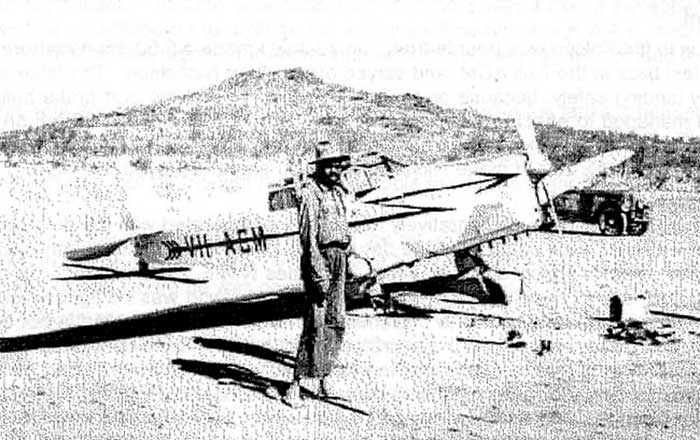
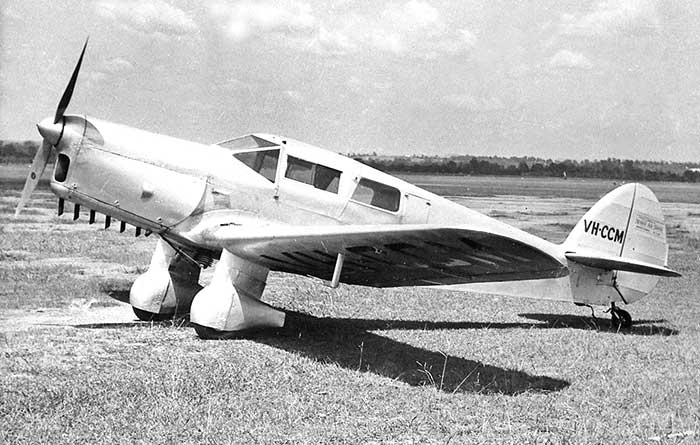
Photo by Howard K. Morris, manager of Morris Air Service
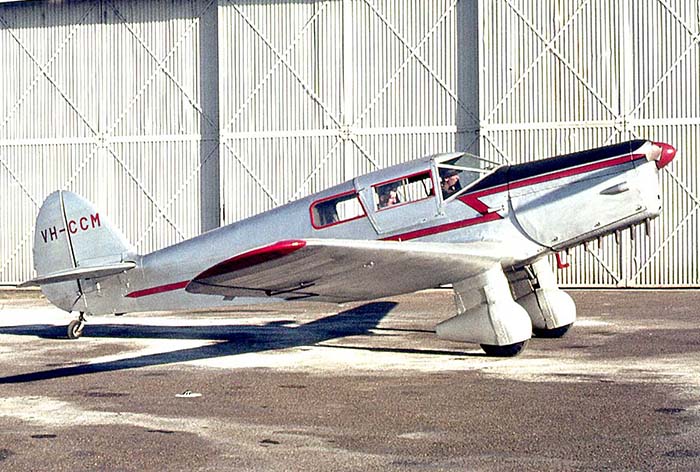
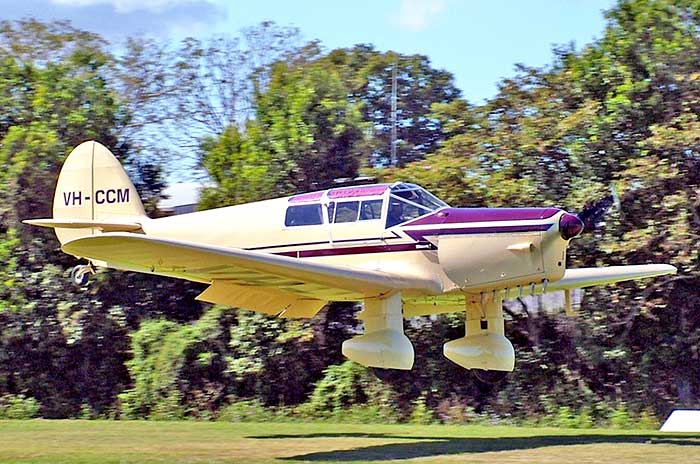
Photo by Bert van Drunick

| .36 | Built Gravesend as Type D.3 Gull Six. Gipsy Six engine |
| 12.36 | Registered HB-OFU: Miss Ariane Dufaux, Geneva |
| 8.1.37 | British CofA issued as HB-OFU |
| 19.1.37 | Departed Heston on delivery to Switzerland |
| Flown regularly on trips to France prior to German invasion of France | |
| 6.42 | Damaged in accident, stored and not flown again until after WWII |
| 8.46 | Repairs completed, now owned by Alfredo Habib, Geneva |
| 58-70 | Owner now Alfredo Habib & J. Augsberger. Geneva |
| 77 | Sold to Cliff Lovell and delivered from Switzerland to England |
| 2.7.77 | HB-OFU visited flyin at Sywell. Light blue and silver, with red rudder with white Swiss cross |
| 16.9.77 | Registered G-AERD Clifford C. & Jennifer M. Lovell, Walkeridge Farm |
| Complete rebuild by Cliff Lovell t/a Hants Light Aircraft Services Ltd | |
| 2.5.80 | Permit to Fly after restoration |
| 30.5.81 | Crashed Thruxton when port wing dug in on takeoff. Severe airframe damage. Rebuilt |
| 28.3.83 | Change of ownership: Neil C. Jensen, Redhill |
| 7.8.84 | Swung on takeoff and collided with taxying PA-28 Cherokee G-BEEU at Cranfield. The Gull suffered wing damage |
| 31.12.85 | Testflown Denham after repair by EMK Aircraft |
| .85 |
Change of ownership: National Museum of Australia, Canberra ACT. Museum stated that the Gull was to enhance their Edgar Percival document and artifact collection |
| .85 | Testflown in Britain to ensure it met the museum’s requirements then flown from Redhill, Surrey to Chessington where it was dismantled by Light Aircraft Services and stowed in a 40 feet ANL shipping container. |
| 28.11.86 | Struck-off Register as sold to Australia |
| .86 | National Museum of Australia purchased the Gull in airworthy condition, but on arrival in Australia there were insufficient funds to fly the aircraft. The proposed museum building was not available, so aircraft was placed in storage |
| 3.90 | Temporarily displayed at National Convention Centre, Canberra as part of a National Heritage Week exhibition. Maroon and silver scheme, G-AERD |
| 12.05 |
Brought out of storage temporarily for display until
March 2006 at the museum’s Captivating and Curious Exhibition, along
with motor vehicles, a giant doll from the 2000 Sydney Olympics and
other exhibits. G-AERD was maroon and silver |
| .06 | Returned to storage, wings removed, at AWM Mitchell Annexe, Canberra |
| Note: the National Museum of Australia earlier purchased airworthy Percival Proctor VH-FEP
in Perth in 1978 which has been in storage ever since. It was reported
that the original plans were for the Proctor to represent the
Australian record-breaking Percival Gulls, but G-AERD acquired in the
mentime |


Percival Gulls visiting Australa on long distance flights
| .38 | Built at Luton by Percival Aircraft Ltd |
| 2.3.38 | Registered G-AFEH H. F. J. Broadbent, Hanworth |
| 2.3.38 | CofA issued, valid from 28.2.38 |
| 12.3.38 | Departed Lympne at 3am on record flight to Australia, pilot
Broadbent. He was attempting to beat Jean Batten's record time |
| 17.3.38 | Damaged propeller and undercarriage during a forced landing at
Sesok, Toren Island, Flores north of Timor. Abandoned record attempt.
Broadbent flew to Darwin on a Qantas flight then returned to repair the Vega Gull with engineer H. Wicke |
| 7.4.38 | G-AFEH arrived Darwin, Broadbent and Wicke |
| 8.4.38 | Arrived Mascot |
| 16.4.38 | Broadbent departed Mascot for Darwin, planning an attempt on the record time to England |
| 18.4.38 | Broadbent departed Darwin at 3am on record flight to England |
| 22.4.38 | Arrived Lympne at 10.51pm in new record time from Australia
of 5 days, 4 hrs, 21 mins. This was the last pre-war record flight |
| 30.6.38 | Change of ownership: Percival Aircraft Ltd, Luton |
| 30.1.39 | Change of ownership: John M. Berwick, York |
| 2.3.40 | Impressed by RAF as X9315 |
| 14.6.46 | Registered G-AHVN Lancashire Aircraft Corp Ltd, Squires Gate |
| 14.6.46 | Re-registration backdated (when previous civil registration was discovered) as G-AFEH |
| 50 | Based Yeadon with LAC subsidiary West Riding Aviation Centre, Yeadon |
| 9.11.50 | Struck-off Register, placed in long term storage |
| 2.52 | noted at Yeadon with engine removed |
| 1.53 | Broken-up at Yeadon |
| .35 | Built Gravesend by Percival Aircraft Ltd as D.3 Gull Six. Gipsy Six engine |
| 29.8.35 | Registered G-ADPR Miss Jean G. Batten, Gravesend |
| 12.9.35 | CofA issued |
| 11.11.35 | Jean Batten departed Lympne on successful record attempt to South America. 2 days 13 hours 15 minutes |
| 13.11.35 | Forced landing Araruama, Brazil due fuel leak, propeller damaged |
| 16.11.35 | Reached Rio de Janeiro |
| 28.12.35 | Forced landing Lynch’s Farm, Bepton near Midhurst, England damaging the undercarriage |
| 5.10.36 | Jean Batten departed Lympne on record flight to NZ |
| 11.10.36 | Arrived Darwin |
| 16.10.36 | Departed RAAF Richmond NSW for Tasman Sea crossing to NZ. Landed at Auckland same day. 11 days elapsed time from England |
| 2.37 | Flown NZ-Australia by Jean Batten |
| 2.37 | Jean Batten flew G-APDR in the search for Airlines of
Australia Stinson A VH-UHH which went missing between Brisbane and
Sydney on 19.2.37. Her fiancé Beverley Shepherd was the co-pilot on the
flight. He was among the 5 on board who were killed, 2 survived |
| 19.10.37 | Jean Batten departed Darwin on record flight to England, arrived Lympne 26.10.37 |
| 17.7.40 | Impressed by British Government as AX866 Operated by RAF painted in camouflage on communications duties |
| 28.1.46 | Disposal ex RAF No.5 Maintence Unit Kemble to Percival Aircraft Ltd |
| 15.8.46 | Restored to Register G-APDR Percival Aircraft Ltd, Luton |
| 23.8.46 | CofA renewed |
| 48 | Flew with name Jean and Jean Batten's pre-war record flights painted on the fuselage |
| 8.52 | Flew in 1952 Kings Cup Air Race #65 |
| 11.8.54 | noted visiting Southend |
| 16.8.54 | Change of owner name, due Percival company restructure: Hunting Aircraft Ltd, Luton |
| 25.4.61 | Change of ownership Allen H. Wheeler/ Shuttleworth Collection, Old Warden Static display at Old Warden |
| 1.1.68 | UK Permit to Fly issued |
| 31.12.69 | Permit to Fly expired. Returned to static display at Old Warden |
| 87-90 | Fuselage and wings rebuilt by Cliff Lovell of Hants Light Plane Services at Coombe Bissett Rebuild and refurbishing completed by Hunting Engineering & Fields, reassembled by Shuttleworth Collection |
| 31.5.90 | First flight after rebuild |
| .96 | Purchased by Auckland Airport Authority, Auckland NZ |
| .96 | Airfreighted to NZ on Singapore Airlines B747 |
| 8.10.96 | Registered ZK-DPR Auckland International Airport Ltd |
| .96 | G-APDR testflown at Auckland-Mangere Airport late 1996 after
assembly, pilot Cherie Marshall After this one flight the Gull was placed on display in the airport terminal. |
| Displayed in terminal Auckland International Airport as G-APDR | |
| Miss Jean Batten did not return to flying after WWII. She died in obscurity in Majorca, Spain 22.11.82 |
| .34 | First Gull built at Percival's own factory at Gravesend as type D.2 Gull Four III. DH Gipsy Major Completed with single-strut undercarriage, revised side & top cabin doors and revised wing-locking mechanism, all of which were developed for the new 1934 model Gull VI. |
| 18.6.34 | Registered G-ACUL Percival Aircraft Co, Gravesend |
| 18.8.34 | CofA issued |
| 19.9.34 | Change of ownership: Lt Patrick Randolph, Sherbourne |
| Randolph, a Grenadier Guardsman, raced the Gull at various events. Painted bright red with silver wings. In June 1936 he traded G-ACUL to Percivals for a new more powerful Percival Vega Gull G-AEKD. | |
| 6.36 | Sold back to Percival Aircraft Co, Gravesend |
| 7.8.36 | Local flight for prospective purchaser Ernie Clark. Repeated the following day |
| Clark was a New Zealand
farmer and enthusiastic private pilot who had
sailed to England for a six month holiday with family. In England he
flew a variety of light aircraft and purchased Avro Avian G-AAHE which
he flew to France and Switzerland. He planned to fly home to NZ but
wanted a higher performing aircraft. After trial flights in G-ACUL on
7th and 8th August 1936 and agreed to purchase the Gull from Percival
Aircraft Co. | |
| Clark
wrote to his NZ aero club suggesting they purchase the Gull and save
the shipping cost by allowing him to deliver it by air. The club
declined his offer. Clark also wrote to the NZ Civil Aviation Department advising he was importing this Gull. Their reply advised that the registration ZK-AES had been reserved for his aircraft. | |
| 5.10.36 | Airframe logbook: 10 minute test flight after overhaul, pilot Edgar Percival |
| 7.10.36 | Change of ownership: L. Ernie Clark, London |
| 7.10.36 | Annual CofA renewal. Repainted as ZK-AES on instructions of owner |
| 7.10.36 |
Airframe logbook: Local flight, pilot Ernie Clark |
| 10.10.36 | Flown Gravesend-Ford by Clark to farewell friends at Yapton Aero Club |
| 25.10.36 | Flown Gravesend to Lympne by Clark. |
| 26.10.36 | Ernie Clark departed
Lympne at 6.20 AM on a solo 14,000 mile flight to NZ. He was farewelled
by his aged mother and family and the Lympne Aerodrome Commander.
Clark's total flying experience was only 141 hours, including 9 hours
on the Gull. He had no radio or radio navigation aids. Newspaper reports quoted Clark saying he "must hurry home for the sheep shearing". |
| 26.10.36 | First night reached Brindisi, Italy. He landed in the dark at a military base but was given a good reception |
| For a detailed description of the flight, including Clark's own words, refer "The Aviation Historian" magazine No.23 April 2018 | |
| 5.11.36 | Koepang, Timor to Darwin |
| 6.11.36 | Darwin-Camooweal-Longreach |
| 7.11.36 | Longreach-Sydney (Mascot) |
| 11.11.36 | Local flight Mascot, and again 14.11.36 |
| 14.11.36 | Mascot-RAAF Richmond NSW |
| 15.11.36 | Departed Richmond for NZ, Clark arrived Blenheim same day after 12 hrs 50 mins in the air. He then flew on to Wigram RNZAF Station at Christchurch arriving after dark to a crowd of 25,000 people. |
| 17.11.36 | Flown by Clark from Wigram to his farm at Waikari, where 400 people welcomed his arrival |
| 5.1.37 | Registered ZK-AES L. Ernie Clark, Waikari |
| 12.8.37 | Change of ownership: Civil Aviation Department, Wellington |
| 19.11.38 | Change of ownership: Canterbury Aero Club, Christchurch |
| 12.9.39 | Impressed by NZ Government. for RNZAF |
| Operated by RNZAF as NZ572, operated by Rongotai Communications Flight | |
| 18.7.40 | Crashed after takeoff RNZAF Hobsonville due engine failure. |
| Footnote: Ernie Clark
later returned to England, enlisted in RAF flying Spitfires before
being posted to Trans Atlantic Ferrying. Transferred to RNZAF in
January 1944 and ended the war with a DFC. Post war he was the Percival agent for NZ. |
- Australian Civil Aircraft Register, Department of Civil Aviation and its successors
- National Archives of Australia: DCA aircraft files
- National Archives of Australia: Dept of Air files on wartime civil aircraft Impressments
- National Library of Australia - Trove newspaper archive website
- British Civil Aircraft Register, G-INFO website
- British Civil Aircraft Since 1919, A.J. Jackson, Putnam 1974
- New Zealand Civil Register, Air Britain Archive series
- Percival Gull, Air Britain Archive series 1990-1991
- Flypast A record of Aviation in Australia, Neville Parnell and Trevor Boughton, AGPS 1988
- Allotment of Civil Registration markings, CAB & DCA file, National Archives of Australia,
Series A705 No.8/103/996 transcribed by Dion Makoswski, Man and Aerial Machines, April 1990
- Failure of Triumph -The Story of Connellan Airways, E. J. Connellan, Paradigm Investments, 1992
- Lewy of the Inland Skies, George W. Lewis, DB Publishing, Manurah WA 2005
- Out of Control in the Centre, John P. Kellow, self-published, Second Edition, May 2002
- The Jimmy Melrose Story, Eric Gunton, self Published, Adelaide, 1990
- Boy Phoenix C. James Melrose, Helen Blake, self-published, Adelaide 2009
- 10,000 Hours, Harry V. Moss, Hesperian Press 1988
- Classic Wings Downunder magazine, renamed Classic Wings: NZ, numerous references to Gull restoration projects
- Flightpath magazine, Melbourne, various references to Gull restoration projects
- The Flying Caseys, Neil Follett, Flightpath magazine, Vol.24 No.2, November 2012
- Flying Home For The Sheep Shearing, Errol Martyn, The Aviation Historian magazine No.23 April 2018
- Rag & Tube, monthly journal of Antique Aeroplane Association of Australia, 1977 onwards
- Air Britain Digest, Autumn 2000: letter from Don Johnson regarding VH-UTP
- Pilot Logbook Captain N.S.Buckley, courtesy SA Aviation Museum